
NORTH AMERICA A supplement to LNG Industry
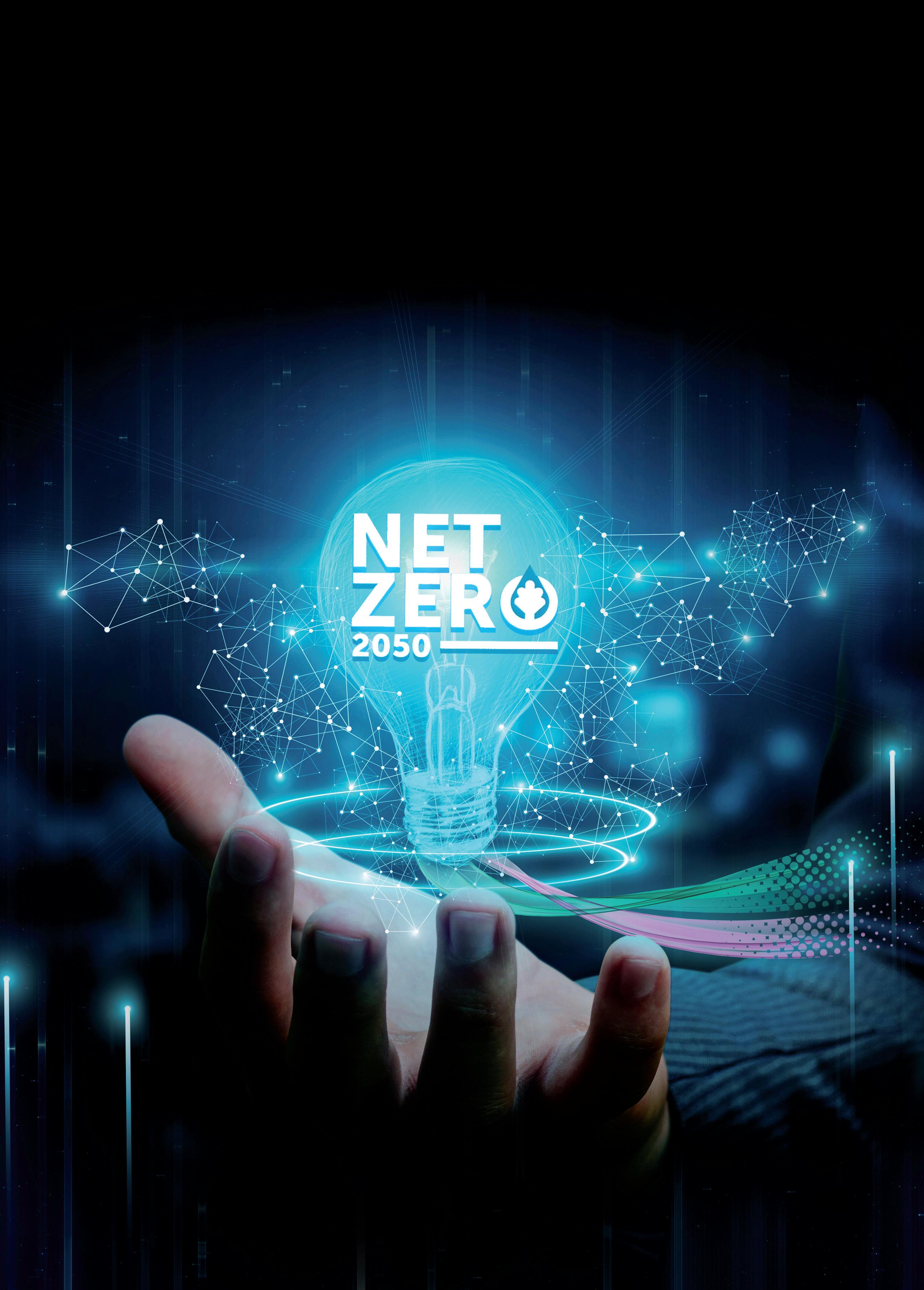
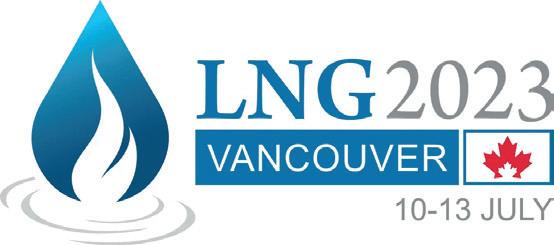

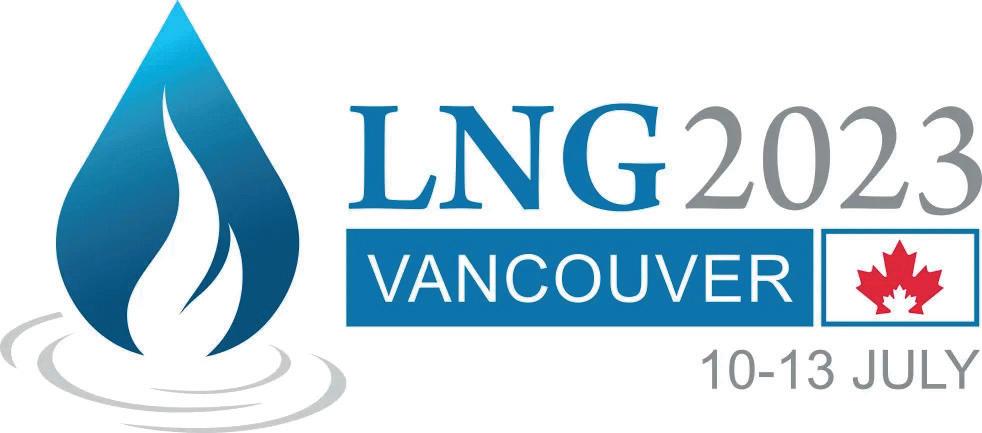
For over 60 years we have only had one thing in mind: making measured values ever more precise. But we also never lost sight of the need for human values, too. By combining these it makes a remarkable radar level sensor possible. The best value there is: VEGAPULS 6X.





WE LOVE RELIABLE VALUES. JUST LIKE OUR RADAR LEVEL SENSOR. THE
®. OUT NOW!
6X
VEGA. HOME OF VALUES. www.vega.com/radar
NORTH AMERICA 2023
05 Comment
16 Pathways to decarbonisation
Rostom Merzouki, Director, Global Gas Development at ABS, discusses how North America is tackling shipping’s climate challenge ambition and reinventing itself in the energy transition to cleaner sustainable fuels, alongside the US’ endeavour to responsibly drive technology initiatives that help to lower fuel consumption while still managing the increasing demand for goods and services transported by ships.
23 LNG leads the race to net-zero emissions bunkering


Steve Esau, COO of SEA-LNG, addresses the important role the LNG industry can play in decarbonising shipping – from its leading position in the race to net-zero emissions bunkering, to how it can leverage bio-LNG and e-LNG to further reduce greenhouse gas emissions and meet future climate targets.
28 Ensuring energy security with small scale LNG
Paul Shields, Chart Industries, explains how small scale LNG could be the answer to achieving energy security and independence.
31 Small scale, big benefits
Christopher Elko, Daniel Harajda, and Amanda Witmer, Air Products, assess the flexibility and versatility of small scale LNG in the future LNG industry.
35 Maintaining the flow in the North American LNG project pipeline

Record prices and the need for energy security have created strong momentum in North American LNG. Kristy Kramer, Vice President Gas & LNG Research, and Sean Harrison, Research Analyst Gas & LNG, Wood Mackenzie, explore why a focus on addressing potential issues with the contracting, financing and construction of projects will be important to keep the healthy project pipeline on track.
39 Made to measure
Hans-Peter Visser, Analytical Solutions and Products B.V., the Netherlands, outlines the needs for fully-automated LNG custody transfer measurement systems.
42 Building an LNG facility and a legacy
Lyle Hanna, Commonwealth LNG, USA, details the creation of the Commonwealth LNG project, and the benefits it can deliver to the local and wider communities.
47 Advancing Alaska LNG
Timothy Fitzpatrick, Alaska Gasline Development Corporation, looks at how shockwaves from Russia’s invasion of Ukraine propelled the Alaska LNG
the history of the Woodfibre LNG project, and how the company is working
CONTENTS ON THIS MONTH’S COVER
Chart's deep cryogenic expertise and proven track record makes the company an ideal project partner to deliver LNG and hydrogen as secure, clean, safe, and affordable fuel alternatives. At the cornerstone of the company's business is a broad portfolio of complementary products, and it is the integration of these products to deliver highly engineered solutions, used from the beginning to the end in the liquid gas supply
ISSN 1747-1826
LNG Industry is audited by the Audit Bureau of Circulations (ABC). An audit certificate is available on request from our sales department. CBP006075
Noam Ayali, Lindsey Swiger, and Jessica Rodríguez, Norton Rose Fulbright US LLP, outline considerations for project developers in the US looking to integrate carbon capture facilities in LNG projects.
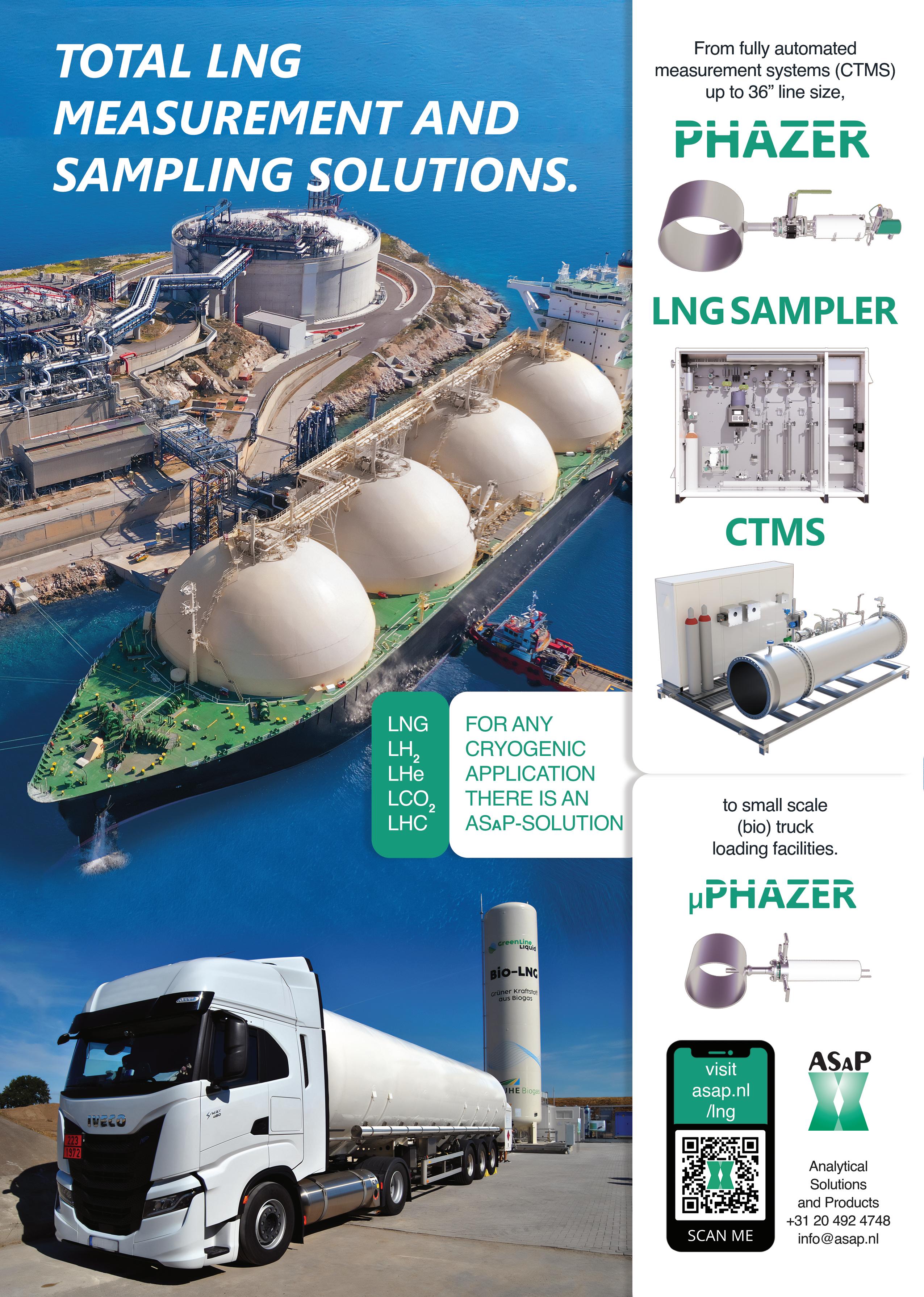 JESSICA CASEY DEPUTY EDITOR
JESSICA CASEY DEPUTY EDITOR

COMMENT
Welcome to LNG Industry’s first North America supplement.
Following the conflict in Ukraine and the subsequent supply-demand imbalance throughout the world, and particularly in Europe, the aim of this magazine is to bring you insights into the recent changes, trends, and developments in the North America LNG industry, as well as updates on some of the current and proposed projects across the region.
The U.S. Energy Information Administration expects natural gas production to rise to 42.1 trillion ft 3 by 2050, largely driven by US LNG exports, which are expected to rise to 10 trillion ft 3 by 2050, as per its Annual Energy Outlook 2023 1
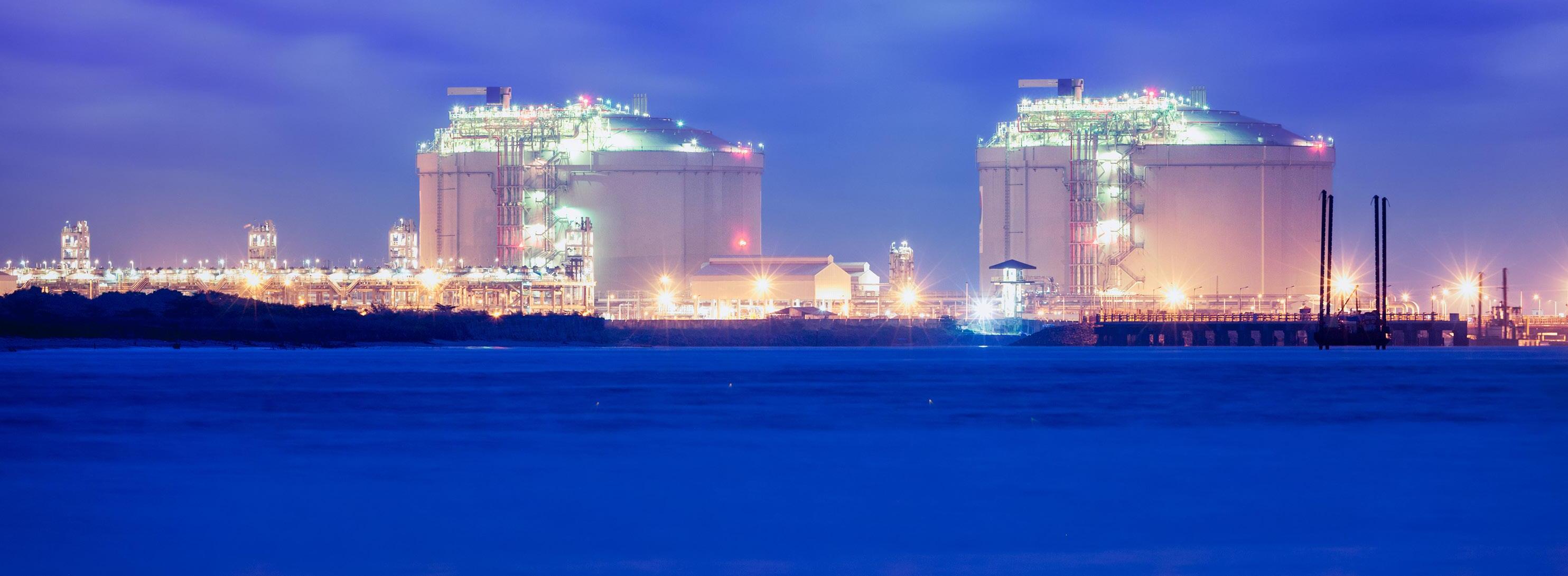
There are three export projects currently under construction that will expand US LNG export capacity by 5.7 billion ft3/d by 2025: Golden Pass LNG (Texas), Plaquemines LNG (Louisiana), and Corpus Christi Stage III (Texas).2 All of these projects are close to the Haynesville Formation and Permian Basin, meaning the amount of natural gas produced can grow along with the demand for LNG.1 There are also many proposed projects in the US that are waiting for final investment decisions before construction can begin. As well as the increased demand for US LNG from Europe, Asia is a potential new market following the continent’s efforts to move away from fossil fuels. Alaska Gasline Development Corporation explain how they are well positioned to serve this market in its article.
In a recent webinar by Poten & Partners, 3 Sergio Chapa, Senior LNG Analyst, explores the potential for Mexico as an emerging LNG export powerhouse. The country has four existing import terminals, with three export projects under construction, and another eight proposed projects
totalling 50.2 million tpy. However, these Mexican exports depend on the U.S. Department of Energy’s non-free trade agreement permits, an uncertain regulatory environment, and US-sourced natural gas. 3
Canada only has one LNG terminal in operation –St John LNG’s regasification import terminal located in New Brunswick, but 18 LNG export facilities have been proposed in Canada, with a total proposed export capacity of 216 million tpy of LNG. 4 Woodfibre LNG’s project case study outlines how the company is working to produce the lowest-emissions LNG from their project in Canada. As McKinsey & Company discussed in its regional report in the June issue of LNG Industry (which will also be distributed at LNG2023), Canada is in a promising position to take advantage of the current LNG market and become a major LNG exporter. 5 It is therefore a fitting location for LNG2023 to take place.
I hope you enjoy this special edition of LNG Industry, and I look forward to seeing you in Vancouver for LNG2023.
References
1. ‘Annual Energy Outlook 2023’, U.S. Energy Information Administration, (16 March 2023), www.eia.gov/outlooks/aeo/
2. ‘U.S. LNG export capacity to grow as three additional projects begin construction’, U.S. Energy Information Administration, (06 September 2022), www.eia.gov/todayinenergy/detail. php?id=53719
3. ‘Latin America: Net LNG Exporter of Importer by 2030?’, Poten & Partners, (24 May 2023).
4. ‘Canadian LNG Projects’, Government of Canada, https://natural-resources.canada.ca/energy/energy-sourcesdistribution/natural-gas/canadian-lng-projects/5683
5. BRICK, J., AGGARWAL, P., DI FIORI, L., DEDIU, D., and PARSONS, J: McKinsey & Company, ‘Capitalising on Canada’s LNG’, LNG Industry, (June 2023).
Managing Editor James Little james.little@palladianpublications.com
Senior Editor Elizabeth Corner elizabeth.corner@palladianpublications.com
Deputy Editor Jessica Casey jessica.casey@palladianpublications.com
Sales Director Rod Hardy rod.hardy@palladianpublications.com
Sales Manager
Will Powell will.powell@palladianpublications.com
Production Manager
Calli Fabian calli.fabian@palladianpublications.com
Digital Events Manager Louise Cameron louise.cameron@palladianpublications.com
Digital Events Coordinator Stirling Viljoen stirling.viljoen@palladianpublications.com
Digital Administrator Leah Jones leah.jones@palladianpublications.com
Digital Content Assistant Merili Jurivete merili.jurivete@palladianpublications.com
Administration Manager Laura White laura.white@palladianpublications.com
Editorial/Advertisement Offices, Palladian Publications Ltd 15 South Street, Farnham, Surrey, GU9 7QU, UK Tel: +44 (0) 1252 718 999 Website: www.lngindustry.com
LNG Industry Subscription rates: Annual subscription: £50 UK including postage £60 overseas (postage airmail) Two year discounted rate: £80 UK including postage £96 overseas (postage airmail) Subscription claims: Claims for non receipt of issues must be made within 3 months of publication of the issue or they will not be honoured without charge. Applicable only to USA & Canada. LNG Industry (ISSN No: 1747-1826, USPS No: 006-760) is published monthly by Palladian Publications Ltd, GBR and distributed in the USA by Asendia USA, 17B S Middlesex Ave, Monroe NJ 08831. Periodicals postage paid New Brunswick, NJ and additional mailing offices. POSTMASTER: send address changes to LNG Industry, 701C Ashland Ave, Folcroft PA 19032.
Nikhil Kaitwade, Future Market Insights, India, considers the impact of emerging technologies on the North American LNG industry.





6
As a result of the war in Ukraine, demand for LNG is increasing and prices are at their highest level in the last 14 years. To shift away from Russian petrol, European buyers have looked to North American suppliers, while Chinese purchasers are now signing long-term agreements after a lull. Supplementary gas-export plants are being built across various North American countries, such as the US. Nations such as Mexico and Canada are also prepared to join as important gas exporters, with plants planned for their West coasts.
Developers and producers of LNG in North America have agreements to sell approximately 48 million t of LNG this year, which would eventually increase exports by 60%


from present levels. By the end of 2023, there might be more than a dozen LNG export facilities in North America, including the eight that are now under development. These advancements are intended to increase the LNG’s present efficiency. This calls for the use of several cutting-edge technologies, including robots and automation, artificial intelligence (AI), cloud computing, and many more.
According to Future Market Insights, an ESOMAR-certified market intelligence firm, the LNG liquefaction market in the North American region is expected to grow with a significant CAGR from 2023 to 2033 as a result of the rising offshore and onshore construction activities in the US and Canada. 1 Due to


7
growing resource availability, technical developments, and new demand sources, LNG business models are shifting. While the majority of today’s trade gas-on-gas pricing is still determined by long-term, spot cargos, oil-indexed contracts, and price transparency are growing, providing possibilities along the whole North American value chain.
Thus, this article will discuss how the autonomous LNG fuelling system can be used to automatically fuel trucks and ships, how the LNG tank management systems can offer better efficiency and safety to the entire refining process of LNG, and how LNG giants use AI to maximise efficiency and production.

Autonomous LNG fuelling system – an automated way to fuel vehicles
The LNG robotic refuelling system was created to provide LNG to moving vehicles in self-contained filling stations along the roadways. The technology is flexible enough to work with both pressurised as well as non-pressurised fuels. The authorisation for the payment is also put into practice.
The LNG fuelling system is entirely self-contained. With this robotic fuelling system, the truck and other LNG-driven vehicles are driven into a target region, where the robotic system uses RFID to identify the truck as a client and begin the fuelling process. Live cameras allow the driver to monitor and, if necessary, halt the fuelling process.
The lifespan of the LNG fuelling products is extended by the robotic LNG system. The hose’s wear is being decreased since the robotic LNG fuelling mechanism keeps it from hitting the ground. Also, the robotic system’s motions are engineered to reduce mechanical stress to a minimum. The LNG nozzle within the instrument of the LNG refuelling system is exactly aligned with the receivers on the vehicle during connection and disconnection. This significantly lessens the amount of wear on the LNG nozzle’s front-facing components.
The primary benefit of the robotic LNG fuelling system is that it allows users to remain a safe distance away from the fuel dispenser as well as the dispenser itself as the LNG is supplied to the vehicle. The gasses in LNG are quite combustible. To reduce the likelihood of an accident, these LNG fuelling systems have received ATEX certification.
The North American company, Wärtsilä’s LNGPac TM, for example, is a fully automated fuel gas supply system for
LNG-fuelled ships that contains numerous modules such as the bunker station, the storage LNG tank, the process equipment, and the monitoring and control system. For every type of ship, Wärtsilä may provide custom or standard LNG systems that are connected with the rest of the Wärtsilä range and include features that maximise energy efficiency on board. Some of the main advantages of this method include:
z The systems’ high level of automated and remote operability.
z Patent for cold recovery to further reduce energy consumption on board lifecycle services.
z Analysing data locally or remotely.
z Connectivity with other Wärtsilä devices is seamless.
z Solutions that have been approved using various storage technologies and set-ups.
z Extensive familiarity with the main classification societies as well as numerous minor classification societies.
Such developments in the North American region are expected to take regional growth to new heights by 2033.
LNG tank management system for enhanced safety
The main goal of the LNG tank management and storage system is to deliver essential LNG tank data via a web-based and user-friendly user interface. To accommodate any plant architecture, the LNG tank management system has several interface choices for communicating with different tank gauging devices and systems. Via the online interface, all necessary information, including gauge setups, interface settings, and type configurations, may be quickly set up.
Depending on the needs of the company, LNG tank management systems show a wide variety of real-time data values and accurately compute inventory characteristics in a graphical or even raw data format. A high degree of safety along with alarm presentation is ensured by a highly sophisticated alarm management system that can be tailored to suit all site needs. A clever, integrated archive system makes all past data instantly accessible. To boost dependability, such systems might be implemented with complete redundancy.
Such emerging LNG technologies enable operations to respond early in a layered tank to minimise a potential rollover and assure terminal safety by delivering precise information on every layer in the LNG tank. A stratification detecting module based on the measurements of level, density, and temperature is incorporated in several advanced versions of such tank management solutions in addition to the regular LNG tank management system.
For instance, a third generation of cutting-edge LNG tank management systems is now being offered by North American company, Scientific Instruments. The most trustworthy option for level, temperature, and density
8 North America 2023
Figure 1. LNG Titans will employ AI to boost productivity and efficiency.




monitoring in LNG and LPG storage facilities is the SI-7000 LTD. Scientific Instruments’ third-generation LTD, the SI-7000, was created to comply with today’s strict safety rules.
With a reduced footprint as well as an intuitive keypad display integrated into the design, accuracy, performance, and dependability have all been improved. The SI-7000 probe is equipped with specialised sensors for measuring level, pressure, and LNG density. These sensors are all housed in a sturdy stainless-steel enclosure. All parts that are exposed to zones 0 and 1 are made of stainless steel, which offers the best corrosion resistance. With the addition of a sturdy stainless-steel chain and a completely jam-proof redesigned vertical gear drive mechanism (VGD), the SI-7000 now offers the most hassle-free and dependable profiling capability in LNG and LPG storage tanks. Such improved safety measures will take care of the safety standpoint in addition to improving overall productivity.
AI to drive the future of LNG – how LNG giants use AI to maximise efficiency and production
Owing to its complexity and operational difficulties, LNG facilities have a limited capacity for production and reduced energy efficiency. For instance, seasonal changes can be seen in ambient temperatures and feed quality. Just a small portion of the data produced is made to effective use. Traditional process-control systems frequently fail to optimise the intricate, non-linear connection between inputs and outputs. Last but not least, current process optimisation systems require too much manual work to adapt to changing real-time conditions.
The liquefaction process may benefit greatly from the combination of AI and domain knowledge since it will result in higher output, less unpredictability in production rates, and reduced emissions intensity. The key to bridging that production gap is teamwork. The domain expertise is combined with machine learning techniques and a thorough understanding of the machines and the environment in which they function, thanks to the contributions of data scientists, process and control engineers, and optimisation specialists.
Enterprise AI software may be created to give these insights and integrate them into the LNG process optimisation procedure based on the convergence of the domain as well as the data. Herein lies the role of the BHC3 coalition. Baker Hughes is one of the major LNG companies in North America, with over 30 years of expertise, and technology present in more than 50 LNG facilities globally, and a team of specialists developing, producing, and maintaining LNG equipment to provide more than 99.8% dependability. The strength of C3 AI, the industry leader in corporate AI software with more than 5 million active AI models along with 1.9 billion predictions generated daily, combined with this to create a powerful new potential.
In the end, the company hopes to establish a continuous improvement loop in which the LNG process feeds data to AI suggestions, the operator acts on the suggestions, and the cycle is improved further. They will use an AI-optimised machine-learning technique to
gradually optimise LNG output through collaboration. They want to achieve that.
The Shell Process Optimiser for LNG, an LNG module developed on top of BHC3 AI software, is one instance of how this may operate in practice. To improve asset performance, the Shell Process Optimiser for LNG integrates machine learning, operational insights, and domain knowledge. It enables engineers to reduce the difference between current and ideal production by modifying operating conditions. As a result, LNG output has increased by 1 – 2%. Similar reasons have encouraged other LNG businesses operating in the North American market to implement AI into their systems to increase the long-term productivity and effectiveness of these systems.
Conclusion
Over 27 LNG liquefaction projects throughout the world are now awaiting permission and are anticipated to begin operations between 2023 and 2026. The other two significant project stages are construction and feasibility, with 16 and 10, respectively. Globally, North America is in the lead with 31 liquefaction projects set to begin operations by 2026. By 2026, the US would have the most project starts internationally (21) compared to other nations. There would be eight projects that would begin operating in Mexico. To increase efficiency and satisfy the growing demand for LNG, several significant firms in the North American area are aiming to integrate innovative technology into their operations.
The US had previously been an LNG importer, but after 2016 the country switched to being an LNG exporter as a result of natural gas discoveries as well as production from the shale revolution. With 10.6 billion ft 3/d of LNG exports in 2022, the US will soon overtake Australia as the world’s second-largest LNG exporter. After just six years of export operations, the US solidified its position as the leading exporter of LNG in the world, even as Russia reduced its natural gas supply to Europe. The use of automation and cloud services across different LNG industry segments is being driven by such potent drivers.
Liquefaction facilities, storage tanks, coolers, and similar cryogenic equipment, as well as regasification plants, are critical technological elements and infrastructure in the conventional LNG value chain. This technology has been around for a very long time. Yet, rather than completely redesigning components, technical advancements continue to focus on increasing energy efficiency. For the upstream and downstream thermodynamic components of the gas cycle, such as gas turbines, heat exchangers, and compressors, higher efficiency and lower losses are sought via research and development.
Hence, in the forthcoming energy period, when environmental effects, investor mistrust, and growing competitiveness will be defining elements, new technology will be the main star, particularly in the North American LNG sector.
References
1. ‘LNG Liquefaction Equipment Market’, Future Market Insights, www.futuremarketinsights.com/ reports/lng-liquefaction-equipment-market
10 North America 2023
TRYMER® PIR





Guiding You Through LNG Systems





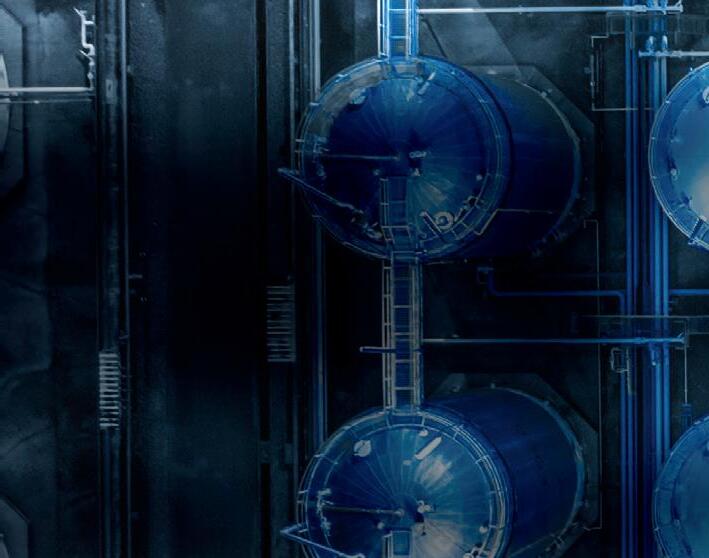
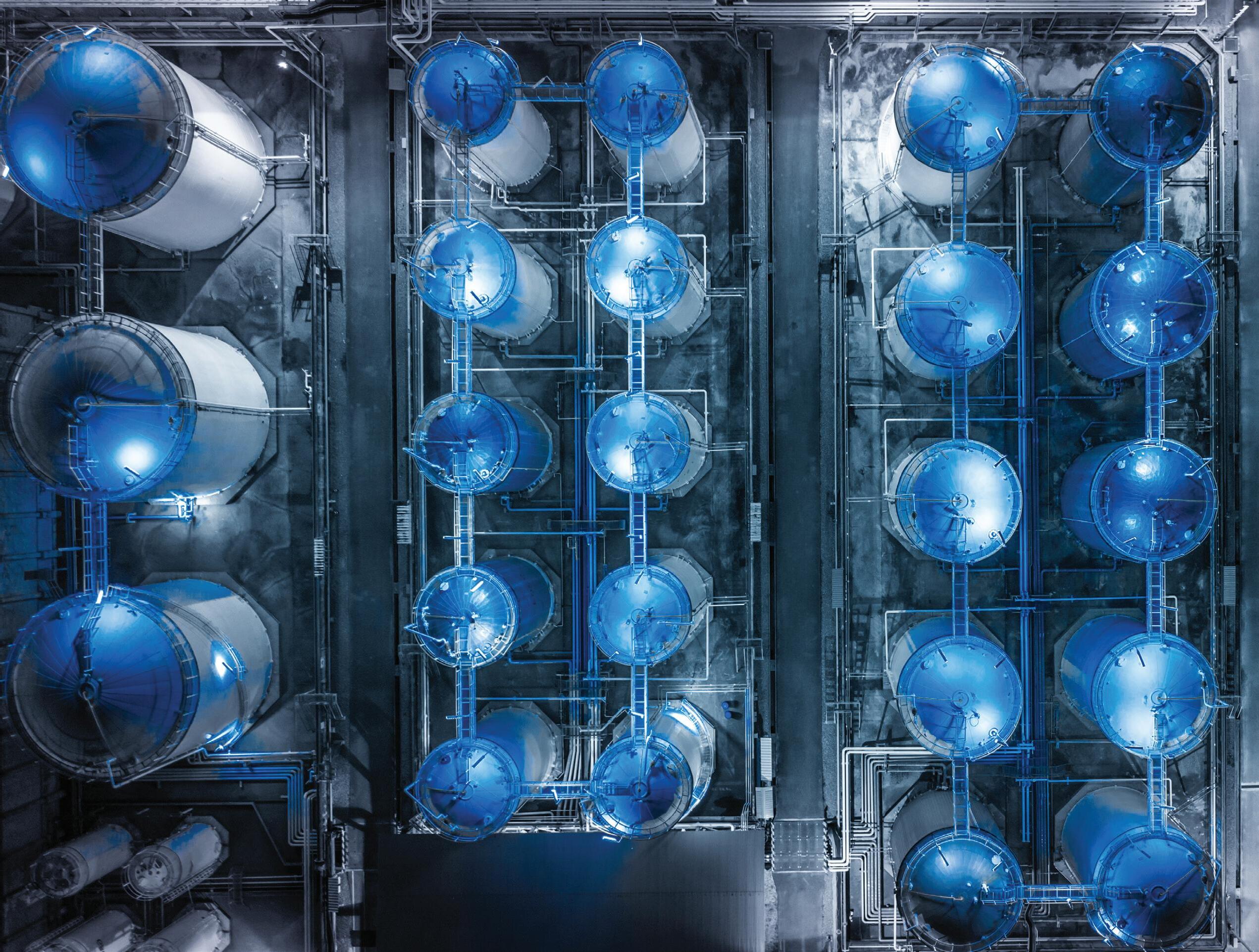
TRYMER® PIR, is a closed-cell, high-performance insulation with a broad temperature range, giving you the perfect insulation solution for not only heated applications but also cryogenic applications, like those found in LNG plants.
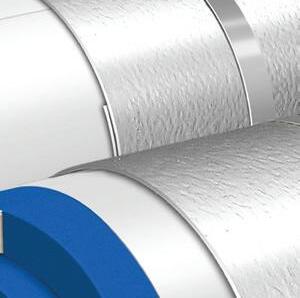


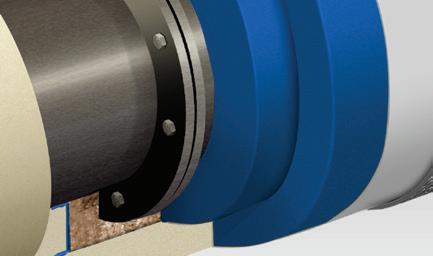


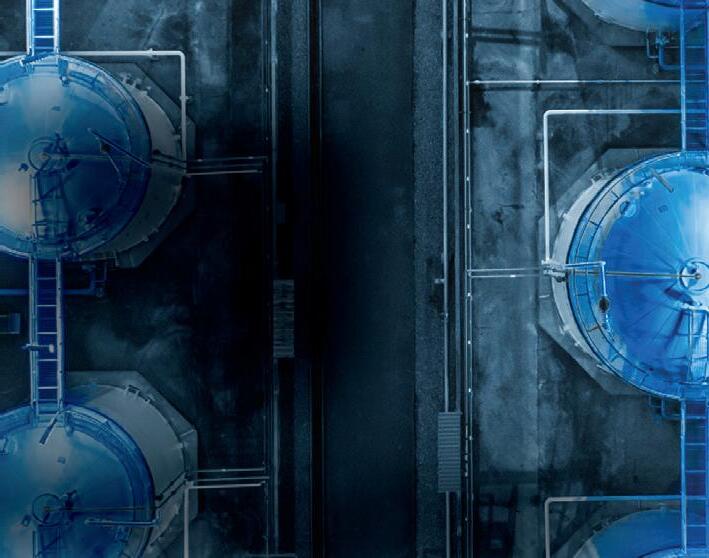
• Economical
• Easy to fabricate & install
• Superior thermal performance


• Available in a variety of densities and thicknesses


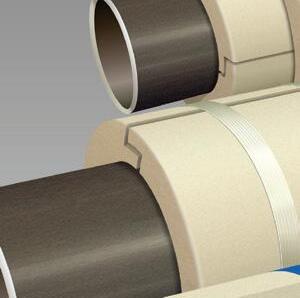

the LNG
Download
Systems Guide
LNGguidesystems availablenow
NEW!
Noam Ayali, Lindsey Swiger, and Jessica Rodríguez, Norton Rose Fulbright US LLP, outline considerations for project developers in the US looking to integrate carbon capture facilities in LNG projects.




12
The LNG industry is reaching a critical crossroads in its development. Demand for US LNG is surging. Fuelling this surge is the combination of key benefits of US LNG (e.g. inherent flexibility as both a domestic and international commodity, lack of destination restrictions, and pricing pegged to US natural gas hubs, such as Henry Hub) with energy security concerns, heightened in particular by Russia’s invasion of, and subsequent war in, Ukraine, which resulted in Moscow’s cutting of supplies to Europe in response to international sanctions.1,2 With at least 16 new LNG projects planned on the US Gulf Coast, the US is expected to become the world’s largest LNG exporter in 2023.2
Due to its lower emissions output than other hydrocarbon resources, natural gas – and LNG in particular – has long been hailed as a ‘bridge fuel’ “that would connect a period of declining coal usage to a future ruled by renewables.”3,4 However, the push to decarbonise and invest in less carbon-intensive energy sources has called into question whether, despite increasing demand, LNG has a place in the energy transition and the global energy mix. In response, LNG suppliers are seeking ways to decarbonise their LNG. This approach has received support, with John Kerry (who currently serves as the first US Special Presidential Envoy for Climate) recently noting that “[g]as is clearly part of the transitional effort,” “[b]ut if you’re going to head to net-zero by 2050, you’ve really got to have some serious capacity to be able to reduce emissions.”1
Carbon capture and sequestration has recently caught the attention of liquefaction facility developers in the US as a route to decarbonisation in LNG. Decarbonising liquefaction operations through carbon capture may help developers meet their own internal decarbonisation goals and those of their offtakers and also may help developers secure financing, as major banks are seeking to reduce their funding of carbon-intensive investments.5 A number of US LNG facility developers are taking this path, including Cheniere Energy Inc., NextDecade Corp., Sempra Energy, Venture Global LNG, and Freeport LNG.6,7
Notably (although beyond the scope of this article) the integration of carbon capture facilities with LNG facilities is not the only method the LNG industry is using or contemplating in attempts to decarbonise. In addition to optimising existing plant facilities, other methods include carbon credits to offset carbon emissions and ship-based carbon capture (installing and operating carbon capture facilities on board an LNG cargo ship).8,9
This article will explore certain considerations that project developers should consider when looking to incorporate carbon capture facilities at or upstream of their LNG facilities for the purposes of decarbonising, or otherwise reducing emissions from, such LNG facilities.
Regulatory framework

In developing any project, one of the primary considerations is the regulatory framework within which that project must exist. Accordingly, developers must consider the regulatory framework required for developing a carbon capture facility in connection with an LNG facility. The regulatory framework for LNG projects in the US is well developed and well understood. At a very high level, the construction and siting of liquefaction facilities is governed by the Federal Energy Regulatory Commission (FERC), while the export of LNG to both free trade and non-free trade agreement countries is governed by the U.S. Department of Energy. Depending on a number of factors, other federal, state, and local agencies also may have jurisdiction with respect to the construction and operation of an LNG facility.
The regulatory regime for carbon capture facilities (and transportation and storage or sequestration of captured carbon),
however, is less clear. Currently, the U.S. Environmental Protection Agency (EPA) maintains authority over underground injection of carbon (unless the EPA has granted primary enforcement authority to a particular state).10 Otherwise, at the federal level, carbon capture projects may require a number of different regulatory approvals depending on the particular project.11 The states also maintain regulatory authority over carbon capture facilities.10 However, not all states have promulgated carbon capture and storage facility laws, and the laws that have been passed vary in content.11 While there are efforts underway to clarify the carbon capture regulatory landscape, the complexities of the current regulatory environment can complicate development of carbon capture facilities, and regulatory counsel should be consulted early in the development process.11
In addition, although carbon capture facilities alone would not be subject to the FERC’s jurisdiction, when attached to an LNG facility, those carbon capture facilities may then be considered part of the FERC-regulated LNG facility.12 Thus, FERC approval of such facilities may be necessary.12 Accordingly, any application to the FERC may be required to contemplate, or existing FERC approvals may need to be amended to contemplate, carbon capture facilities that will be integrated with an LNG facility.
Timeline
Those looking to incorporate carbon capture facilities with or into LNG facilities should be cognisant that doing so can result in a development timeline longer than what might be expected for an LNG facility alone. As discussed later in this section, various factors can contribute to this delay.
Primary among these factors is the regulatory timeline. As discussed, including carbon capture facilities as a part of an LNG facility may require a FERC application to contemplate those carbon capture facilities or may require amendment of an LNG facility’s already-obtained FERC approval (if the carbon capture facilities were not originally included in the design of the LNG facility). Expanding the scope of a FERC application or amending a FERC order can delay FERC approval of the project from the outset or require additional time for the FERC to consider the amendment application. This is because the FERC will require time to consider the impact of the carbon capture facilities in each case, including thorough review of any public comments that may be submitted to the FERC in response to the carbon capture facilities. Other regulatory agencies with jurisdiction over the carbon capture facilities also may require time for consideration thereof and issuing approvals related thereto.
Any appurtenant delay should be reflected in the development, construction, and commissioning timeline in all agreements and documents (including financing documents) related to the LNG facility and the carbon capture facility. In the case of an LNG facility in which carbon capture facilities are contemplated from the onset, project developers should take care that the development schedule and major milestones for the LNG facility as stated in contracts relating to the facility and elsewhere contemplate the timeline for development of both the LNG facility and the carbon capture facility. In the case of a carbon capture facility added later to an LNG facility already in development, project documents and regulatory approvals (including the original FERC order approving the LNG facility, which often includes a construction deadline) may need to be amended to incorporate any carbon-capture-related timeline extension.
Lastly, incorporating carbon capture facilities may result in delays because a carbon capture facility addition requires development of an entirely new project. A project developer will have to undertake the design and engineering for, and ultimate construction of, the carbon capture facility as well as put into place the commercial and legal
13
infrastructure of the carbon capture facility. Naturally, these activities may lead to a longer development timeline than development of an LNG facility alone.
Project development and financing
Although construction timelines for, and the general requirements for development of, LNG facilities are generally understood in the industry, development of industrial scale commercial carbon capture facilities in the US is relatively untested. While a full description of the requirements for developing a carbon capture project is beyond the scope of this article, US developers must consider that a carbon capture facility requires land on which to be situated, potentially pipeline infrastructure to transport captured carbon, and a means for disposing of captured carbon, either through a location in which to store the captured carbon, a buyer for the captured carbon, or a means of utilising the captured carbon. Supply chain issues and the ability to obtain component parts for construction of the carbon capture facility also could complicate development and construction.
Of particular note regarding difficulties in carbon capture facility development, ownership of pore space for the storage of captured carbon is still a question that has yet to be definitively resolved in many states in the US, making storing captured carbon a legally and commercially complicated process. Further, the market for captured carbon is limited at this time, with enhanced oil recovery being the primary use of captured carbon.13
Parallel to developmental timeline concerns, project developers also must determine where in the financing process the carbon capture facilities will be included, and whether they will comprise part of the larger financing of the LNG facility itself or will be financed separately. For example, developers and their commercial teams should consider the scope of their facilities and whether the opportunity would be attractive to financing sources in different segments of the market, what the implications of a ‘single consolidated’ financing vs separate entities/separate ring-fenced financings are, and ultimately what the market can support in terms of competing facilities or other low-carbon investment opportunities. Further illustrating the complex, interconnected nature of the integration of LNG and carbon capture facilities, the decision with respect to financing may hinge, in part, on the timeline for development and permitting of the carbon capture facility relative to the timeline for development of the LNG facility.
Finally – and arguably most importantly – incorporating a carbon capture facility with an LNG facility will likely also have tax implications for developers, including structuring requirements related to tax credits under the Inflation Reduction Act and Section 45Q tax credits for carbon sequestration.14,15 A nuanced discussion of tax credit qualification is beyond the scope of this article, but US project developers are well advised to carefully review the changing tax landscape as they bring these facilities online. In addition to tax structuring, corporate structuring also will play a key role in the development of the facility. For example, developers must determine whether the carbon capture facility will sit within its own entity, be part of the common facilities, or sit within another, already-existing entity within the project structure. These structuring questions also may impact tax considerations as well as regulatory filings, including those made with the FERC.
Greenwashing claims
Given that environmental considerations are one of the primary drivers for incorporating carbon capture facilities into an
LNG facility, LNG project developers undoubtedly will want to publicise the environmental benefits stemming from such carbon capture facilities. However, advertising the environmental benefits of carbon capture facilities associated with LNG facilities is not without risk, as it could lead to claims that the reported environmental benefits are being overstated or misrepresented, often characterised as ‘greenwashing’ claims.16 A failure to, or even a perceived failure to, accurately represent the environmental benefits of the carbon capture facilities could lead to action against an LNG project developer from project stakeholders, commercial counterparties, environmental groups, or even regulators.
These actions bring to light a variety of factors that complicate how developers report the benefits of carbon capture facilities (or other methods of reducing the environmental impact of LNG facilities). For example, claims may centre on the fact that the LNG delivered is not ‘carbon neutral’ or ‘net zero’ because the carbon reduction method employed at the LNG facility reduces only certain emissions (e.g. Scope 1 and Scope 2 emissions [emissions from sources that are owned or controlled by an organisation and emissions associated with an organisation’s purchase of electricity, steam, heat, or cooling], but not Scope 3 emissions [emissions that result from assets not owned or controlled by an organisation]) and the amount of emissions purported to be offset is inaccurate.8,17,18 The varied and complex landscape of emissions calculation and reporting standards and requirements could create difficulties for developers in ensuring that reporting of environmental benefits correctly represents, or is perceived to correctly represent, the actual environmental benefits that a carbon capture facility affords.
Accordingly, project developers should be thoughtful when describing any environmental benefits of a carbon capture facility associated with an LNG facility, including paying close attention to the substance of public statements and project developer interaction with stakeholders.
Conclusion
Integrating carbon capture facilities with LNG facilities offers US LNG project developers an opportunity to balance competing but urgent needs – the need for secure and reliable energy, as well as the need to continue to decarbonise and meet global climate goals. However, as highlighted above, developing carbon capture facilities together with LNG facilities can be a complex process that requires careful consideration and planning.
References
A comprehensive list of this article’s references can be found on the LNG Industry website: www.lngindustry.com/special-reports
Notes
Noam Ayali, Lindsey Swiger, and Jessica Rodríguez would like to thank Jenelle Tubergen, an Associate in Norton Rose Fulbright’s Houston office, for her assistance with this article.
As legal advice must be tailored to the specific circumstances of each case or matter, nothing provided herein should be used as a substitute for the advice of competent counsel. This article does not constitute legal advice, does not necessarily reflect the opinions of Norton Rose Fulbright or any of its attorneys or clients, and is not guaranteed to be correct, complete, or up-to-date.
14 North America 2023
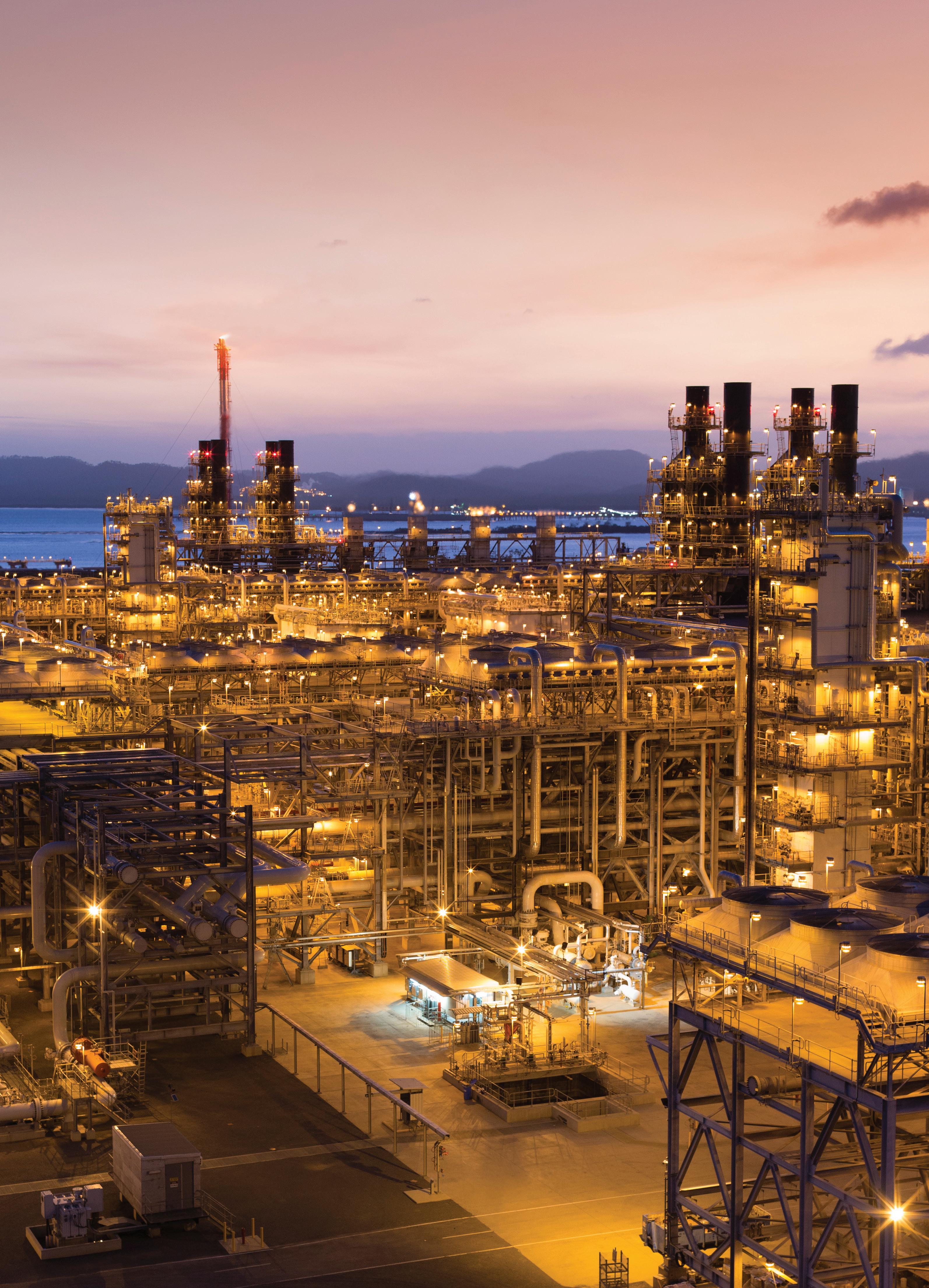


Rostom Merzouki, Director, Global Gas Development at ABS, discusses how North America is tackling shipping’s climate challenge ambition and reinventing itself in the energy transition to cleaner sustainable fuels, alongside the US’ endeavour to responsibly drive technology initiatives that help to lower fuel consumption while still managing the increasing demand for goods and services transported by ships.
LNG as a marine fuel represents an available and competitive solution that contributes to the International Maritime Organization’s (IMO) long-term strategy of reducing greenhouse gas (GHG) emissions from ships. It uses generally light, small-molecule fuels with high energy content, but more demanding, mainly cryogenic, fuel supply systems and storage. This includes the relatively mature methane (such as LNG) solution leading towards bio-derived or synthetic methane, and ultimately to hydrogen as fuel. On this pathway, if methane slip is discounted, LNG can reduce carbon dioxide (CO2) emissions by 20%; bio-methane can be carbon neutral, while hydrogen is a zero-carbon fuel.
Expanding the operating parameters of marine LNG across North America
Seven years ago, the US exported almost no LNG. Now, as Europe increasingly relies on US gas exports, the US must establish its own strategy for gas.
Imports of LNG are currently concentrated across certain developed nations: just eight LNG importers have absorbed 74% of global LNG trade. US exports were shipped to 36 different countries in 2022, but Europe absorbed the lion’s share of US LNG (64%).
LNG from the US has become the second-largest source of gas imports to Europe, after pipeline gas from Norway, following accelerated Russian pipeline cuts over the summer of 2022. Other nations –including Norway, Azerbaijan, and Qatar – have stepped up their exports to Europe, collectively adding 28 billion m3 in 2022. But the US, supported by its recent increase in liquefaction capacity, added 37 billion m3, more than all other LNG sources combined.
As the Shell LNG Outlook 2023 reveals, 80% of new LNG supply by 2030 will be from Qatar and the US based on new long-term LNG sales and purchase agreements (SPA) showing Europe’s shift to long-term supply commitments towards LNG for its energy security.

16

17
While recent political events have been costly, energy security in Europe rests on US natural gas exports. Europe’s shift from Russian gas to other supplies has dramatically changed global gas trade and energy markets. Leveraging US LNG to deliver lowest-emissions gas, clean hydrogen, and zero-emissions shipping will be key to maintaining momentum in the transatlantic energy trade and securing a clean energy system. Public-private partnerships in Europe and the US could reinforce transatlantic co-operation in securing supply chains.1
Many questions for US policymakers remain: How will LNG export demand be balanced with domestic consumption of gas? How will political leadership capitalise on the economic and geopolitical benefits of LNG exports? How will domestic environmental regulations, infrastructure, and permitting decisions affect the US response to this crisis? Answers to these questions will help Europe understand the strength of the transatlantic energy partnership.
The world is going to have to begin to balance what it is facing today, which is, essentially, how to handle energy security relative to the short-term energy security challenge and the longer-term energy transition. LNG is going to play a leading role in this. However, for such a key fuel for the energy transition, it is important to recognise it is itself a fuel in transition.
Developing economics
According to Clarksons Research’s Shipbuilding Review 2022, more complex ships were ordered – including a record 182 LNG orders worth US$39 billion – and alternative fuel investment increased to a record 61% of tonnage ordered, all supporting a 6% increase in value of orders to US$124.3 billion.
Ordering was dominated by LNG, which represented 36% of total compensated gross tonne (CGT), together with container vessels with 350 ships and 29% of total CGT, which, while down 50% y/y, was still the third largest on record on a TEU basis. Car carrier (69 vessels, 2.4 CGT), FPSO, and ‘wind’ niches also did well.
Increased tanker orders are thought likely for 2023, along with a continued flow of LNG – despite the average price for a 174 000 m3 vessel being US$248 million at the end-2022, up a significant 18% y/y.
The latest ABS Zero Carbon Outlook indicates that significant investments had been made in newbuild tonnage, with a particular focus on containerships and gas carriers. The trends indicated that LNG, methanol, and LPG will have a starting point advantage over the other fuels currently considered, at least until the middle of the decade. Based on the vessel type and applications, the fuel uptake will vary. For example, it is expected that more large bulk carriers will adopt LNG compared to smaller vessels. The tanker sector’s adoption of alternative fuels is expected to lag bulk carriers.
The expected future fuel mix will inevitably involve a rapid reduction in oil-based fuels from close to 80% today to less than 30% by 2050 with LNG, methanol, ammonia, and hydrogen rapidly increasing in adoption. Ammonia and hydrogen will be carbon free if they are produced by the green pathway. The uptake will depend on several factors, availability of fuel being one apart from the readiness of ports and bunkering infrastructure.
Short-term actions making the transition faster
There is growing recognition that decarbonisation will not be a ‘single one-stop fuel’ process where the industry moves in a single step from fossil to zero-emission, renewable fuels. Accelerating decarbonisation efforts in the maritime and shipping industry, marine LNG is known to help to cut sulfur emissions by 99%, fine particle emissions by 99%, nitrogen oxide emissions by up to 85%, and GHG emissions by up to 23% (well-to-wake [WtW]).
The EU Member States are implementing the Fit For 55 package, the umbrella regulation that includes the FuelEU, the EU’s ETS extension to the maritime transport sector, an update Energy Taxation Directive, and initiatives on the deployment of Alternative Fuels Infrastructure. The expansion of the EU ETS to the maritime transport sector will bring the cap-and-trade approach to an industry level. For each individual vessel, the implementation will be more like carbon taxation with a payment obligation for each tonne of carbon emissions from the vessel. In this instance, the tank-to-wake emissions and the fuel consumption as reported within the EU monitoring, reporting, and verification (MRV) framework are only considered. The FuelEU Maritime mechanism expands carbon-output calculations beyond present tank-to-wake estimates to include well-to-tank emissions, which better reflect energy lifecycles. The initiative aims to incentivise the use of low-carbon fuels, as well as the shore power connection of specific vessel types (containerships and passenger vessels) and thereby escalate the transition to carbon-neutral shipping. The FuelEU Maritime initiative makes use of the lifecycle approach on a well-to-wake basis to derive the carbon footprint of fuels including CO2, nitrous oxide (N2O), methane slip, and the carbon dioxide equivalent (CO2-e) emissions from electricity used during port stays. Future developments in carbon trading schemes around the world and regulations show a trend in using WtW data.
Bio-LNG, produced from sustainable biomass resources, is also commercially available today and output is rising. SEA-LNG indicates there are 78 production plants set to be up and running within the EU alone in the next two years, and output should expand ten-fold by 2030.
The US has the capacity to produce the most LNG globally. Traction in developing LNG bunkering infrastructure is expanding, with several leading ports and LNG bunker suppliers having established key initiatives and made significant progress in support of these developments. As the World LNG Report for 2022 highlights, the US’s bunkering operations currently take place primarily at the Port of Jacksonville in Florida and Port Fourchon in Louisiana. Jacksonville has conducted truck-to-ship operations since 2016 for two containerships and added ship-to-ship (STS) bunkering services to the facility with the delivery of the Clean Jacksonville bunker barge in 2018. The Clean Canaveral, a 5500 m3 bunker barge, was also delivered to Jacksonville in late 2021. Port Fourchon completed the bunkering of its first LNG-fuelled vessel in 2016 and has plans to become a central LNG terminal in North America. With the arrival of the 4000 m3 Q-LNG 4000 ATB unit and its dedicated tug Q-Ocean Service in early 2021, Port Canaveral in Florida is on track to become the US’ first LNG cruise port. The Q-LNG 4000 vessel will operate from Port Canaveral to provide LNG fuel to
18 North America 2023
Serving the future with years of experience.
DSC offers over 30 years of experience in repairs and services spanning all types of vessel operating in the natural gas arena, from LNG carriers and FSRUs (Floating Storage and Regasification Units) to servicing LNG-fueled vessels.
Damen Shiprepair Brest offers one of the largest docks in Europe (420x80m) with tunnel access enhancing logistical flexibility. In combination with the size of the shipyard and adjacent port terminal facilities, deep water quay side possibilities and specialised LNG services (GTT license), Brest is a perfect location for servicing LNG vessels.
Additional location is Damen Shiprepair Verolme, capable of servicing this type of vessels with its large dock (400x90m), quayside availability as well as surrounding infrastructure.
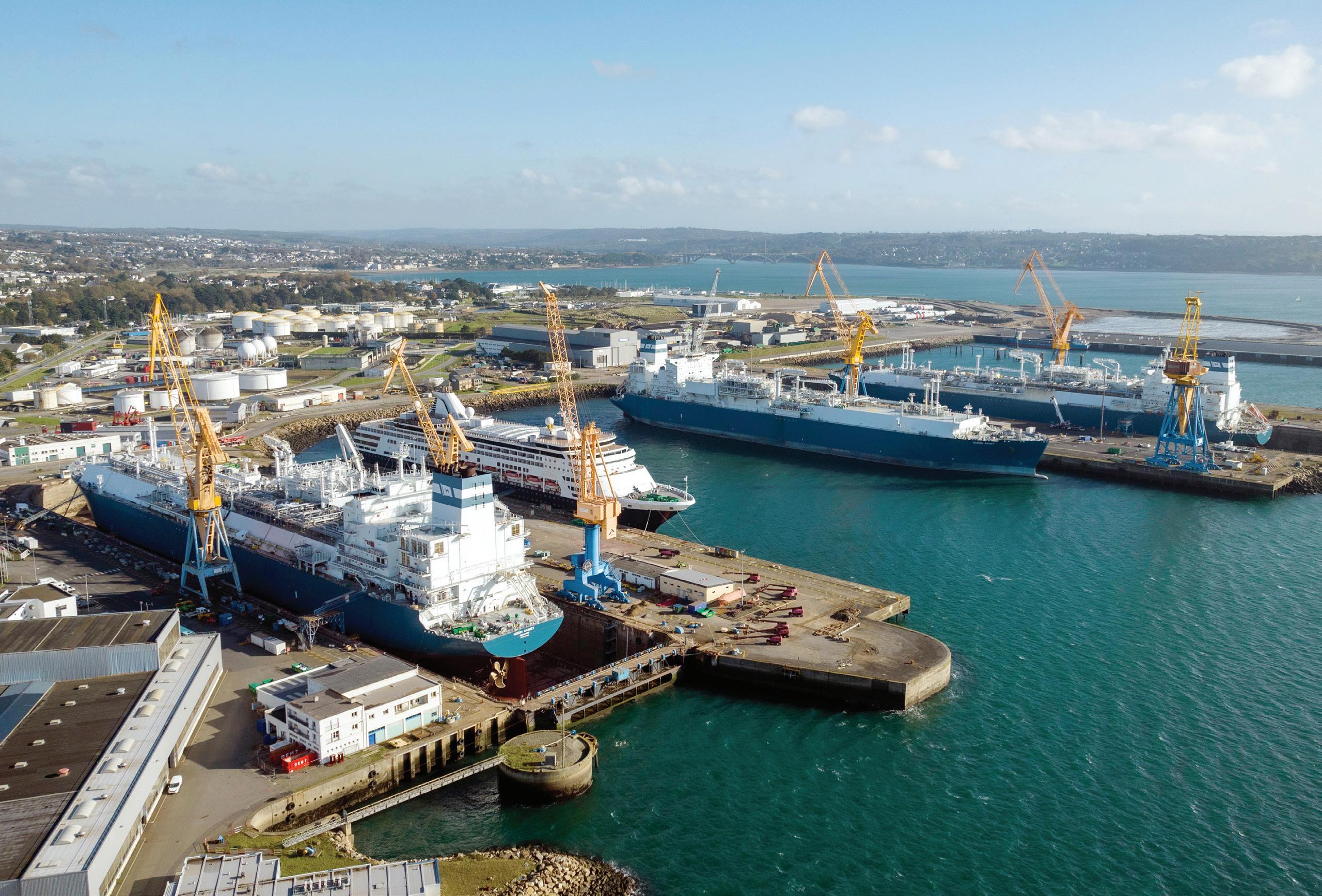
Our reference list is growing by day, tackling a wide range of our Clients’ demands: from complexity of the GTT certified cargo tanks and sub-cooler installations to standardised BWTS installations and regular hull surveys.
With the new demands emerging from the EEXI and CII regulation, we are there to serve our Clients’ needs further on their pathway towards compliance.
Find out more on Damen.com
Pictured here:
Damen Shiprepair Brest
cruise ships after loading LNG from a fuel distribution facility on Elba Island, Georgia.
Projects set to go live include Sempra Energy’s Port Arthur plant in Texas, Energy Transfer LP’s Lake Charles in Louisiana, and NextDecade Corp’s Rio Grande in Texas. Recently, ExxonMobil agreed two 20-year deals with Mexico Pacific Ltd from the planned 14.1 million tpy Saguaro Energía LNG project on Mexico’s Pacific coast. Others include Brownsville LNG, Golden Pass, Freeport, Cheniere, and Tellurian.
The US can export around 11.8 billion ft3 this year and 12.6 billion ft3 next year, according to estimations by the U.S. Energy Information Administration. The seven export plants already in service, including Freeport LNG, can turn approximately 13.8 billion ft3 of gas into LNG each day.
Shipping as the enabler of the clean, green energy transition
For shipping, the challenge and opportunity lies in two pathways: shipping for shipping, which is the decarbonisation of the industry and shipping for the world, which highlights shipping’s role as an enabler of the global green energy transition.
Industry will be fundamental in supporting the emerging value chains in shipping which is complex and with unique challenges to navigate. It is a multi-dimensional lifecycle hybrid solution with numerous boundary conditions impacted by technology and infrastructure readiness timelines. Complex integrated energy management systems, new materials and processes, improved ship connectivity, increased application of autonomous functions, and real-time performance optimisation are some of the challenges today.
Any selection of the most appropriate fuel pathway and related technology is certainly a challenge for both vessel operators and their owners, which includes considerations of the vessel’s size and design, as well as evaluation of whether lower or higher energy content fuels will best match its operational profile.
Pushing the technology parameters in the evolution of green shipping corridors
The U.S. Department of State (DOS) has provided high-level guidance on green shipping corridors and the current administration has promulgated several climate related laws that have created a supportive regulatory and policy framework which the shipping industry could take advantage of over the next decade.
Formation of a green corridor is a techno-regulatory-commercial undertaking and will require comprehensive expertise. Typically, most corridors announced are between two ports, but there are more being developed which focus on a business case that is at the centre of the corridor development, e.g. the Australia-Japan Irzdor and the Chile Green Corridors focus on green hydrogen. Forming a consortium based on a pre-feasibility assessment followed by a top-down approach analysing each part of the value chain and their individual criteria will help to make decisions based on solid quantitative backing.
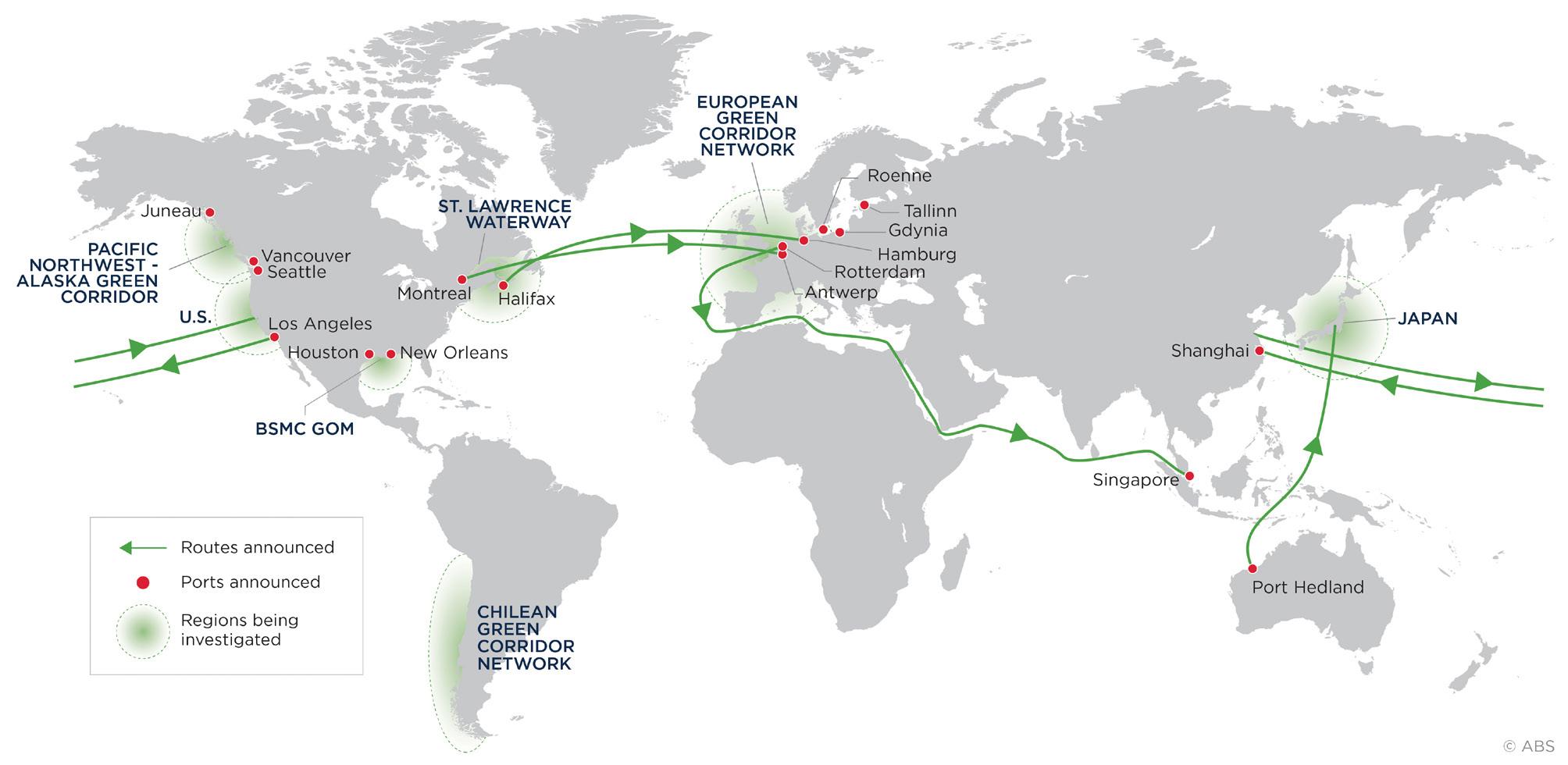
From a fuel perspective, LNG, ammonia, hydrogen, and methanol seem to be the front runners from a decarbonisation viewpoint, and from a technology standpoint, battery-powered and fuel cell vessels could play a role, at least for short-range applications.
Dual-fuel engine technology is also making the transition to alternative low- and zero-carbon fuels much easier, and are technologies that can be factored into the design of new vessels, especially fuel tanks. ABS classed the Harvey Energy, which features a dual-fuel (LNG/diesel) engine equipped with a battery-converter system. A 1450 kW battery was installed as part of a hybrid energy solution that was designed to reduce the ship’s exhaust emissions, fuel consumption, and noise levels. In February 2022, Harvey Gulf International Marine announced that it has begun to operate one of its ‘tri-fuel’ vessels exclusively on battery power and renewable LNG (RLNG), with diesel fuel as backup. RLNG is recaptured swine and dairy farm gas from pigs and cows. The use of RLNG enables the dual and tri-fuelled RLNG vessels to carbon neutral.
20 North America 2023
Figure 1. ABS map identifying locations of green shipping corridors.
BRIGHTER FUTURE COOLER BY DESIGN ®

Chart’s LNG power generation solutions provide natural gas to hundreds of thousands of homes. This is one way Chart facilitates LNG as a safe, clean-burning fuel for energy, transportation and industry.

Learn more at www.ChartLNG.com LNG@ChartIndustries.com
Onboard carbon capture will be a useful technology to help bridge the gap between traditional fuels and alternative fuels. Carbon capture utilisation and storage will begin to play an important role in reducing emissions in both carbon-intensive processes and in the growing use of low-carbon fuels, such as LNG, methanol, or biofuels. Carbon capture is also essential to the production of fuels such as blue hydrogen and ammonia, which could also help to power the next generation of maritime assets. Nuclear vessels are a possibility but the public relations issues may prevent usage despite being technologically sound and proven.
Increased electrification through advanced energy storage systems (ESS) may serve an essential role in the path to decarbonisation. ESS such as batteries, kinetic ESS, or supercapacitors offer broad application potential. They could be used in a hybrid arrangement, improving the efficiency of hydrocarbon-burning vessels. ESS could also be used in the small scale production of green alternative fuels for powering various systems. Use of advanced ESS is expected to see increased use on board marine vessels and offshore assets as 2050 approaches.
In the future, a third generation of biofuels, such as lignocellulosic or algae-based fuels, could potentially provide the industry with almost 500 million tpy of fuels, more than the current annual bunker demand. This group includes electro/synthetic gas-to-liquid (GTL) fuels produced though either carbon capture and electrolysis, or from converting biomass to syngas and then to liquid fuels, such as methanol or diesel.
According to ABS’ future fuel mix forecast, alternative fuels will take off post-2030. This means construction of those vessels should start in the next 2 – 3 years and even in 2050, there will be enough vessels which will still operate with traditional fuels. When vessels with alternative fuels begin operating, they will find a natural home in the announced green corridors assisting with viable operations despite the higher expected fuel costs.
Green shipping corridors are a nascent conceptual idea which will need to be tested in the physical world. If there is an industry that can make this work, it is the shipping industry with its rich history of co-operating with numerous stakeholders in a supply chain. Co-operation and collaboration are at the bedrock of any green shipping corridor.
Creating an integrated model with all stakeholders in the marine ecosystem to understand and evaluate the potential, feasibility, and profitability of green corridors is subjected to variations in operating conditions, policies and financial instruments.
Collaborating with industry
Developments in digital twins, modelling and simulation, generative design, alternative fuels, green ecosystems, and the blue economy are technologies that represent significant industry paradigm shifts: future fuels and energy sources, approaches to design and construction that reflect digital processes, software that empowers people and analysis that feeds back into the design and production phases. These shifts demand they are approach with a fresh mindset and new tools, prompting the elevation to a new performance level and leverage new technologies.
ABS is leveraging on its organisation’s low-carbon expertise to provide industry-leading services and solutions, as well as guidance to assist vessel owners in selecting alternative fuels such as LNG. It is committed to working closely with industry partners and customers to intensify investigation into these technologies and future fuel solutions.

In the shorter term, retrofitting vessels with LNG and biofuels (both seen as good transitionary fuels) appears to be the most viable option. New vessels, on the other hand, could be designed to incorporate the likes of ammonia, methanol, hydrogen, and fuel cells and represent more of a longer-term strategy that ABS expects to see investment into over the coming decades. As marine and offshore transitions away from the combustion of hydrocarbons, fuel-cell technologies are also drawing careful attention from shipowners.
While everyone has a part to play in not just the ‘here and now’ of cleaner marine fuels, but in the sustainable development of tomorrow’s carbon-free future of shipping, it is clear not a single industry participant can deal with this decarbonisation challenge alone. Collaboration with stakeholders across shipping’s value chain is essential to accelerate the speed of R&D and commercialising sustainable fuels of the future – and at scale.
References
1. Center for Strategic & International Studies, www.csis.org
22 North America 2023
Figure 2. Key outcomes by stakeholder from the ABS Green Corridors Simulation, a service designed to support international design and development of clean energy initiatives.
Steve Esau, COO of SEA-LNG, addresses the important role the LNG industry can play in decarbonising shipping – from its leading position in the race to net-zero emissions bunkering, to how it can leverage bio-LNG and e-LNG to further reduce greenhouse gas emissions and meet future climate targets.
LNG is already a clean shipping fuel success story because of its unparalleled reduction in harmful local emissions and the fact that it offers cuts to greenhouse gas (GHG) emissions of up to 23% on a full lifecycle, or well-to-wake basis, compared with traditional oil fuels. This provides a firm foundation for further emissions reductions as LNG transitions from a fossil fuel as growing volumes of bio-LNG and e-LNG become available.
The story so far
The shipping industry currently represents approximately 3% of total global emissions. According to the

Fourth International Maritime Organization (IMO) GHG Study 2020, these emissions are projected to increase from about 90% of 2008 emissions in 2018 to 90 – 130% of 2008 emissions by 2050. The marine fuels and shipping industries therefore need to encourage demand for lower carbon fuels and supporting the demand with commercial supply.
Changes in local emissions regulations in the shipping industry in the past decade – for example the introduction of the IMO’s Sulphur Cap in 2020 and Emission Control Areas in Northern Europe, North America, and the Caribbean – have driven the uptake of LNG as a marine fuel. LNG offers a well understood solution –
23
over 60 years’ experience of using and transporting LNG gives it a structural advantage over other alternative marine fuels in areas such as safety, handling, infrastructure, and supply chain organisation.
In recent years, LNG has been the fastest-growing alternative fuel option among orders of newbuild deep-sea vessels. Based on the current confirmed newbuild order book, the LNG-powered fleet is forecast to grow from fewer than 200 vessels in 2020, to close to 900 by 2030. If current trends continue, several thousand LNG-powered vessels could be in operation by the end of the decade.
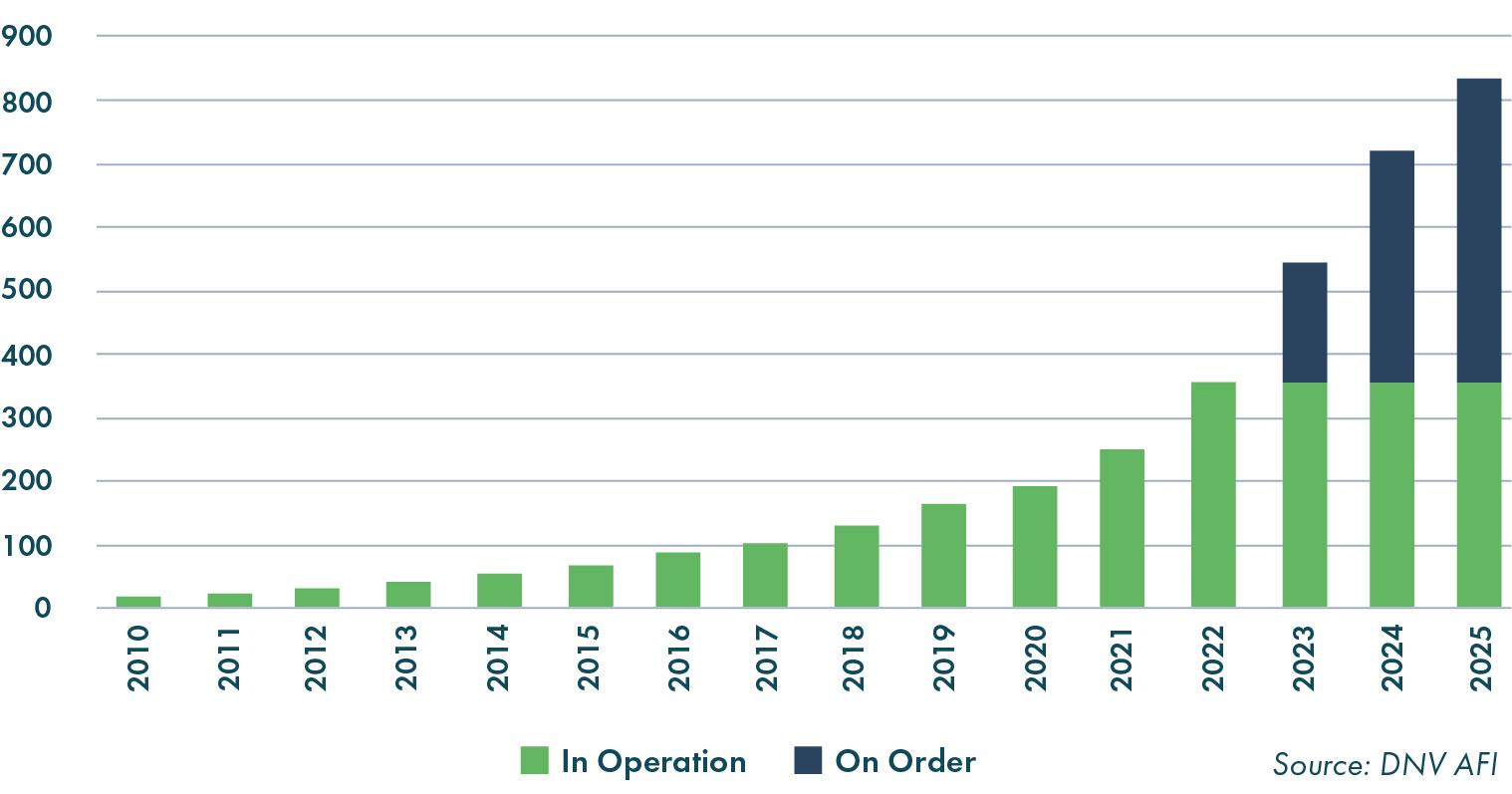
The potential market for a clean marine fuel is huge and diversified. The shipping industry is unlikely to rely on a single solution; it is likely to need a basket of fuels to support different vessel types and shipping routes. LNG and its pathway to net-zero carbon is a viable solution for many. Future net-zero carbon-based marine fuels will recycle existing carbon in the atmosphere without releasing fossil carbon, and some may help reduce carbon through post-combustion carbon capture and storage.
Today’s challenges
Today, no zero emissions fuels exist in the quantities necessary to satisfy the demand from shipping.
Different fuels have different levels of technology readiness and investment needs across vessels and engines, fuel production, supply infrastructure, and for regulatory and safety requirements.
Shipping’s basket of fuelling options will likely include a mixture of bio-derived and synthetic, or electro-fuels, such as bio-LNG (also called liquefied biomethane [LBM] or renewable natural gas [RNG]), bio-methanol, e-LNG, e-methanol, e-ammonia, and e-hydrogen. All synthetic fuels are derived from the same building block: hydrogen produced via electrolysis. The capacity for producing synthetic fuels will rely on the build out of electrolysis capacity to produce sufficient hydrogen feedstock. To be net zero, these fuels need to use renewable electricity in their production.

Crucial to filling the basket with truly net-zero fuels will be assessing and understanding, for each fuel choice, the full lifecycle carbon emissions of the fuel from production to combustion. Tracing fuel pathways allows for comparing not just the emissions impact of a particular molecule, but the overall environmental impact of a molecule’s pathway to net zero. It is crucial that decision making is guided by accurate information that assesses the alternative fuel pathways on a like-for-like and full lifecycle (well-to-wake) basis.
Bio-LNG is already meeting the industry’s requirements for an environmentally friendly fuel and is being used in as a drop in fuel in North-West Europe and the US. Bio-derived fuels produced from waste streams can be effectively net zero and, given certain conditions in their supply chain, they can even be carbon negative.
Decarbonisation in action
By the end of 2022, there were 40 LNG bunkering vessels operating around the world in northern Europe, the Mediterranean, the US, Canada, South Korea, Japan, Malaysia, China, Singapore, Brazil, and Australia. 2022 saw commercial ship-to-ship bunkering of LNG taking place for the first time in China, the Caribbean, and Russia. The year also saw the number of ports where LNG was available increase by nearly one-third, from 141 to 185, with further expansion anticipated to bring the number of ports offering LNG bunkering to more than 230 by mid-decade.
24 North America 2023
Figure 1. Growth of LNG-fuelled fleet.
Figure 2. Alternative marine fuel pathways must be assessed on a like-for-like basis.

Florida is a thriving location for LNG bunkering for the shipping industry, with the pioneering TOTE Group working with a number of other businesses to develop significant commercial experience in the region. For example, TOTE’s Orca class of vessels, which sail between North-West US and Alaska, have been converted to run on LNG.
Seaside LNG operates the largest fleet of LNG barges in the US, including Clean Jacksonville and Clean Canaveral (the largest LNG bunkering vessel in the country), and is expecting delivery of a sister bunker barge, Clean Everglades, by the end of 2023. Seaside LNG supplies LNG through JAX LNG, North America’s first small scale liquefaction plant serving the maritime sector, located in the Port of Jacksonville.
The LNG bunkering vessel, Clean Jacksonville, completed its 300 th fuelling operation at the JAXPORT Blount Island Marine Terminal in Jacksonville, Florida, just four years after it was commissioned.
Canada-based Seaspan Maritime Transportation is expanding LNG bunkering operations in the Pacific Northwest, with orders for two 7600 m 3 LNG bunker vessels. The first vessel is expected to be delivered and in operation in 2024.
Most recently, in March 2023, Shell and ZIM announced an LNG supply deal, which was inaugurated in Jamaica, as ZIM’s latest container vessel Sammy Ofer bunkered LNG at Shell’s new location in Kingston.
In November 2022, major carriers including NYK, CMA CGM, and Carnival all underlined their commitment to the LNG pathway and called for more bunkering infrastructure to maintain LNG’s central position in the basket of fuels.
From grey to green
All future alternative fuels, including LNG, ammonia, methanol, and hydrogen, share a similar pathway from ‘grey’ fossil feedstocks to ‘green’ electro or synthetic fuels. To be successful in meeting climate goals, the shipping industry will need to address issues associated with these new fuels such as safety (toxicity and flammability), technology maturity, energy density, fuel supply infrastructure, and fuel availability.
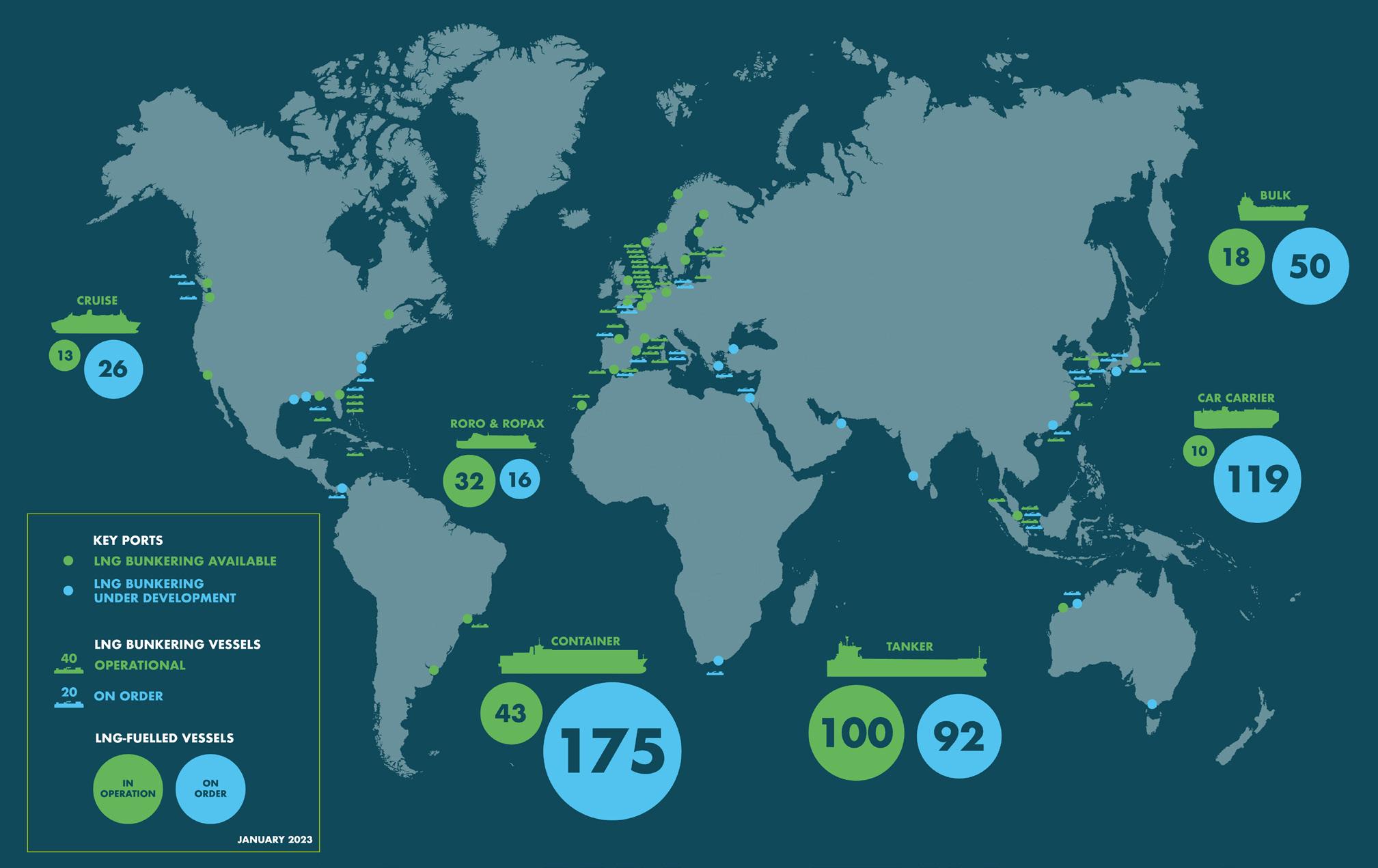
Some fuels, such as LNG and methanol, will have a bio-phase, with bio-LNG and bio-methanol produced from human or agricultural waste. Others, such as ammonia and hydrogen, are only likely to be produced from fossil fuels (mainly natural gas) or renewable electricity. While bio-derived fuels are about double the cost of their fossil counterparts, they are significantly cheaper than their electro-fuel equivalents.
LNG’s pathway to net-zero for bunker fuels, through the use of bio-LNG and synthetic LNG, is clear and well defined. These fuels can be blended with fossil LNG, providing an incremental, lower-cost transition towards low-carbon LNG fuels for industries along the entire value chain. They can be dropped into existing infrastructure and fuel systems without need for expensive modification.
The bio and synthetic pathways are not exclusive and can run concurrently. This means, for example, that applications that use LNG today can reduce emissions and tackle decarbonisation while lower-carbon alternatives are becoming available. The cost of e-LNG will be on a par with other e-fuels, as 70 – 80% of the cost of producing these fuels depends on the cost of producing hydrogen from renewable energy.
26 North America 2023
Figure 3. Worldwide growth in LNG use and infrastructure.
2030 and 2050 solutions
Bio-LNG produced from sustainable biomass resources has the potential to meet a significant proportion of future shipping energy demand, even taking into account growing demand for biomass feedstocks from other sectors, such as wood and paper production, industrial processes, heat and power generation, aviation, and heavy-duty road transportation.
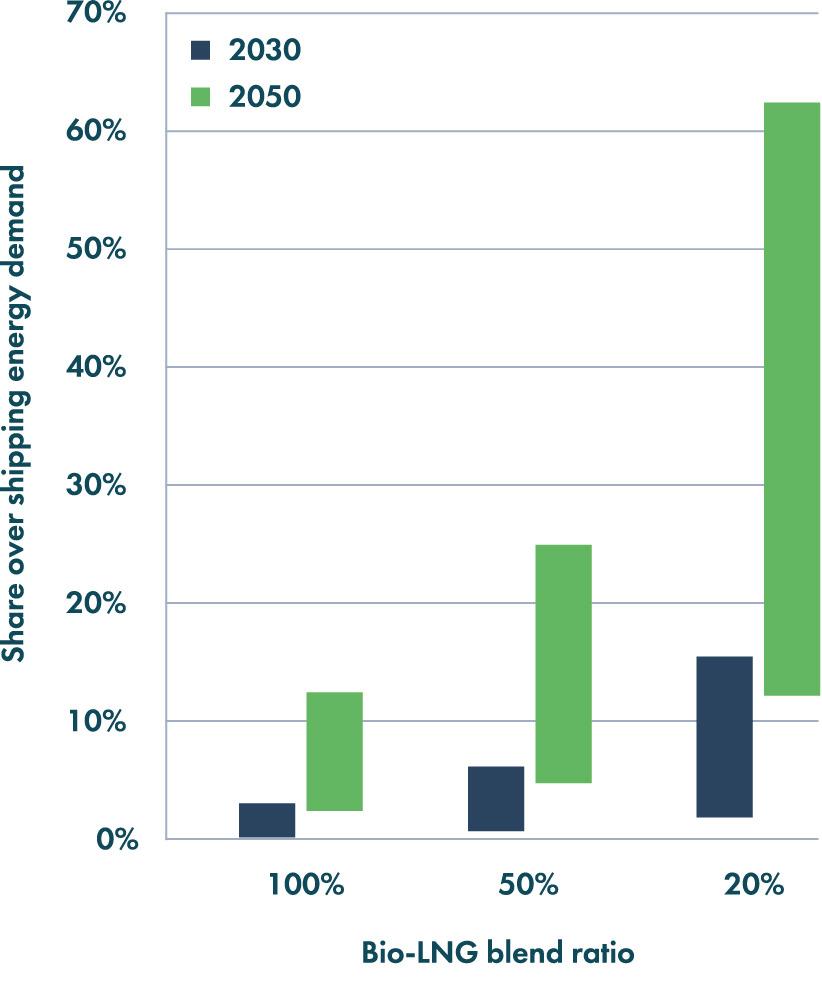
Bio-LNG is already available for bunkering in north-west Europe and North America. For example, energy major, Shell, has announced an agreement with the container shipping company, Hapag Lloyd, to supply liquid biomethane to 12 cargo vessels operating between Europe and Asia.
This fuel can be blended in relatively small amounts, meaning it can help the industry hit key milestones in 2030 and beyond. Pure bio-LNG could cover up to 0.4 – 3.1% of the total energy demand for shipping fuels in 2030 and 2.4 – 12.6% in 2050. Blended at 20% with fossil LNG, bio-LNG could cover up to 15.7% of total shipping energy demand in 2030 and 62.9% in 2050 and meet decarbonisation targets.
Longer term, e-LNG is likely to play a more important role. This process will be a gradual one, as renewable energy sources, electrolysis plants, and fuel production capacity is built out.
The overall transition is likely to be incremental, utilising drop-in fuels and existing infrastructure to keep risks and costs as low as possible – this makes the LNG pathway a highly attractive option for ship owners.
What can the LNG industry do?
The LNG industry has responded well to meeting the demand from the growing LNG-fuelled fleet. The main challenge to be addressed is the fact that the maritime industry is accustomed to buying its fuel on the spot market, while the LNG industry is underpinned by long-term deals which support its large capital investments on the supply side.
The uptake of bio-LNG and e-LNG will require continued investment by the LNG industry in the traditional supply chain and potentially new investments in bio-methane and e-methane production. It will also demand the industry’s traditional expertise in operations, supply, and trading.
New challenges will need to be met, for instance, maximising bio-LNG’s role in decarbonising the shipping industry will require a supportive regulatory framework. This will include robust certification schemes, clear mass-balance and Guarantees of Origin systems enabling bio-LNG supply and trading operations to capitalise on the existing infrastructure built up over decades for LNG and natural gas.
In summary, there is a clear role for the LNG industry to support the maritime energy transition with opportunities for first movers to develop new markets, new services, brand recognition, and technology leadership.
benefits of the LNG
pathway are illustrated using simple calculations of GHG emissions over the lifetime of a mid-sized container vessel. The vessel comes into operation in 2025, is dual-fuelled with a 25-year lifespan, and renewable fuels are assumed to become available at increasing scale from about 2030 onwards. The graph illustrates how LNG offers immediate GHG reductions decreasing to zero-emissions by 2050. Note, the example of a single container vessel is used for simplicity, whereas the insights obtained apply at a fleet level.
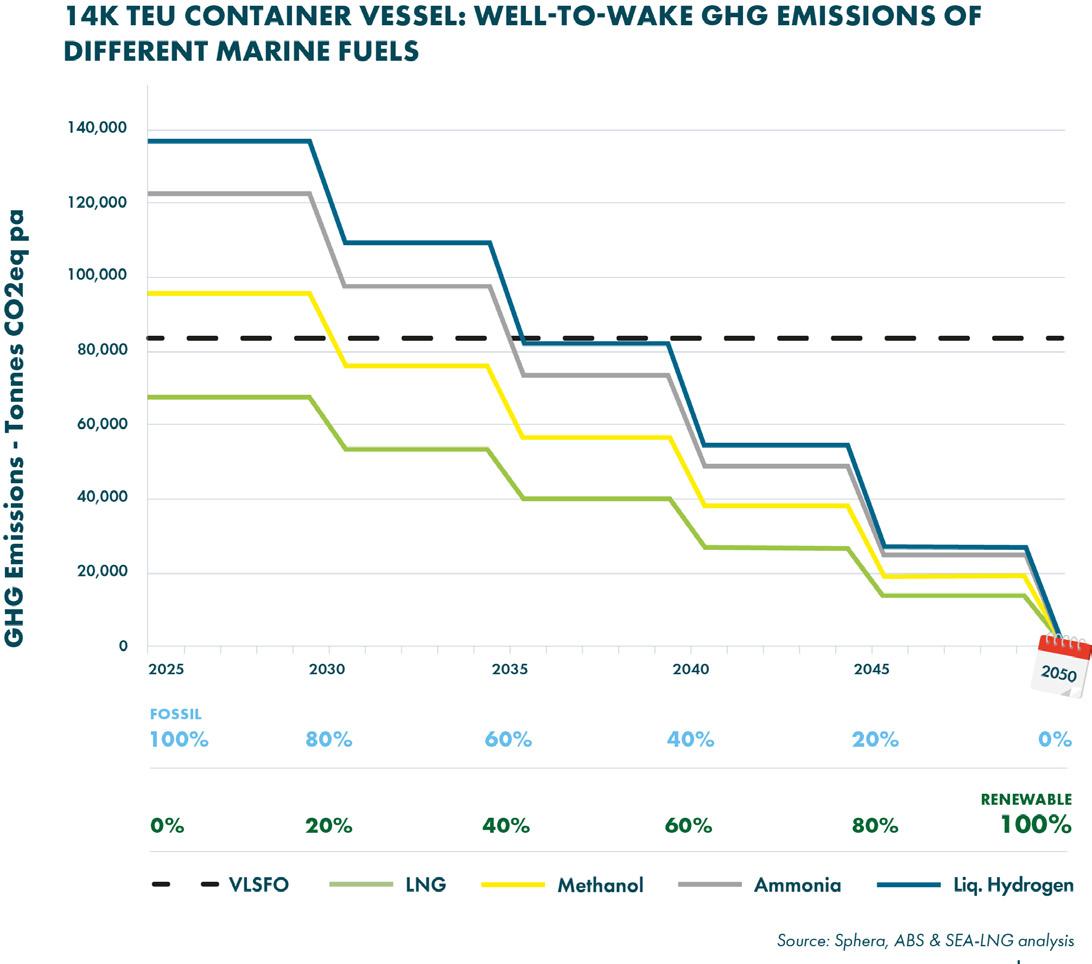
North America 2023 27
Figure 5. Potential availability of bio-LNG for shipping sector in 2030 and 2050 over total shipping energy demand, with different blending rates with fossil LNG.
Figure 4. Comparison of decarbonisation pathways: The
decarbonisation

28
Paul Shields, Chart Industries, explains how small scale
With natural gas viewed as the gateway fuel to a lower carbon energy future, and Europe committed to transitioning away from imported pipeline gas, North American LNG is viewed as a near-term solution for many, with new liquefaction capacity coming online and other liquefaction terminals moving toward final investment decisions. However, as well as replacing pipeline gas, LNG also affords the opportunity to provide gas to regions and enterprises that are not connected to the pipeline grid and provide energy security during peak times, curtailment of pipeline supply, and to supplement renewables when unfavourable climatic conditions do not generate sufficient supply.
LNG virtual pipelines and the small scale value chain
The process of bringing LNG from its source to the point of use is called the virtual pipeline and typically covers four stages; liquefaction, distribution, storage, and end-use, collectively known as the value chain.

Liquefaction reduces natural gas to 1/600th of its gaseous volume, making it economical to transport and store. Traditionally, liquefaction plants were defined as peak shaving or baseload depending upon their function and capacity. Regardless of size, a single custom plant design was used to achieve
total capacity; hence, as technologies and manufacturing capabilities improved (particularly for the baseload model), the trend has been towards ever larger capacities to realise economies of scale. However, particularly in the US, modular mid scale has gained significant traction. Here, total plant capacity is achieved through multiple identical liquefaction modules instead of a single custom plant. By utilising proven, standard equipment packages, shop build is maximised, which reduces on-site construction and results in significant cost and schedule savings. Other advantages of the modular approach included an overall reduced risk profile, the option for trains to be brought online and operated independently for earlier revenue recognition, and operators being able to have greater opportunity to respond to demand fluctuations.
At the other end of the scale, it is now possible to economically liquefy much smaller quantities of LNG and plant capacities nominally between 10 – 725 tpd (3000 – 450 000 gal./d) of LNG are available. This means that as well as liquefying pipeline gas to create the source for a regional virtual pipeline, captured methane (biogas) can also be liquefied and added to the energy mix, reducing carbon emissions further.
From liquefaction to end use, LNG is transported and stored in cryogenic containers. Cryogenic storage tanks are available in a range of sizes, nominally from 6000 l to > 1 million l, and can be orientated horizontally or vertically. Each tank is specially constructed to keep the LNG at temperature and provide safe and effective extended storage. Tanks are shop-built with a high degree of standardisation, making them much smaller than a site built alternative – this means far less site-work, civils, and permitting during the installation phase. Standardisation also facilitates modularisation so, just like modular liquefaction, total storage capacity is made up of multiple identical storage modules rather than a single large tank.
The same tank technology is also applied to vehicles used to transport LNG. Readers will be familiar with seeing trucks delivering liquefied air gases and the solutions for LNG are basically identical. Cryogenic ISO containers facilitate multi-modal transportation, for example road and sea. A perfect example of this solution in action is the megawatt power station on Madeira Island, which has been operating successfully for many years. LNG is loaded at the import terminal in the Port of Sines and transported to the island in a fleet of ISO containers. A full for empty swap system, where empty ISO containers are collected and returned to Sines for refilling, makes the whole process highly efficient and sustainable.
End-use
This section will demonstrate how the small scale model operates in practice for two key applications: gas to power and natural gas vehicle fuelling.
LNG could be the answer to achieving energy security and independence.
29
A regasification station, also referred to as an LNG satellite station, incorporates storage, vaporisation, pressure regulation, and control systems to deliver natural gas exactly as if it were from a physical pipeline. They can be configured for any demand requirement and enable businesses, regions, and municipalities to transition from diesel, heating oils, and other sources to natural gas. There are hundreds of examples where this has been applied to single businesses and many larger scale examples, including the 80 MW power station at Gibraltar that powers the territory and a series of five regasification stations
Standardisation and modularisation are again key features. All equipment is shop built, standard production, and already proven in the field, which minimises engineering and production costs, schedule, and risk. Total capacity is achieved by connecting multiple storage modules. Smaller capacity stations are typically supplied skid mounted to facilitate simplified transport and installation. Even the larger megawatt stations use shop-built equipment that can be transported by road and installed with significantly reduced site-work, civils, and permitting vs a site built alternative. Modularisation also means that planned facility expansions can be incorporated into the base design.

Providing flexibility
The virtual pipeline and LNG regasification can also benefit users who are connected to a grid but looking to supplement insufficient or unreliable pipeline capacity to meet additional load and seasonal variations or provide emergency fuel back-up during outages. Using LNG is far more efficient than diesel or LPG back-up, as the model simply mimics their current supply solution; liquid fuel is delivered to the site where it is off-loaded and stored for use, except they are using stored natural gas to augment pipeline natural gas and can utilise the same delivery system.
The small scale LNG model is also an effective supplement to renewable resources for when the sun does not shine or the wind does not blow.
LNG vehicle fuelling
Earlier this year, the NGVA announced Europe’s 500th fuelling station for LNG powered heavy haulage trucks. Stations are available in a range of sizes, from private relocatable ones through to stations with multiple dispensers and open to the public. Larger stations are typically located in strategic locations, such as ports and major motorway intersections and can also be equipped with compressed natural gas modules to provide a refuelling service for all natural gas-fuelled vehicles.

LNG is loaded at source, which can be an import terminal, storage/distribution hub and/or liquefaction plant, and delivered to the individual fuel stations in exactly the same way as discussed.
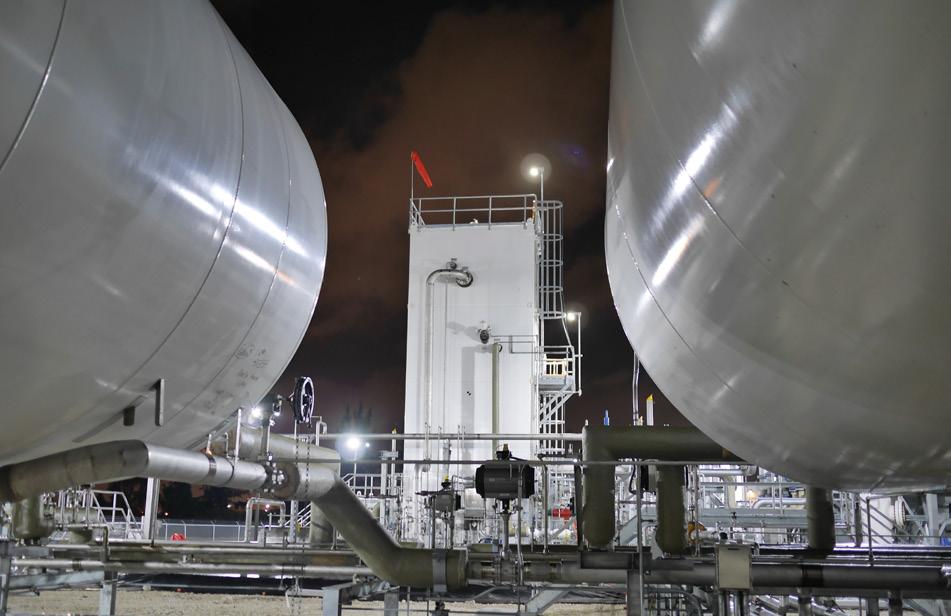

Summary
LNG helps with what is referred to as the ‘energy trilemma’, finding the balance between affordability, security of supply and driving down emissions. The small scale model is an excellent vehicle for increasing natural gas penetration enabling LNG to go beyond simply replacing imported pipeline gas and is an important tool in the journey towards a low carbon future.
30 North America 2023
Figure 4. The small scale LNG value chain enables natural gas to penetrate beyond simply replacing imported pipeline gas.
Figure 3. Storage and revaporisation plants are an integral part of the virtual pipeline, bringing natural gas to businesses and regions not connected to the pipeline grid.
Figure 2. Modularised cryogenic storage reduces project complexity, lead time, permitting, and civil engineering.
Figure 1. The standard plant model has enabled the cost effective liquefaction of natural gas for smaller quantities of gas, including liquefaction of bio-methane.
As the world seeks energy security in the face of the energy transition and geopolitics, demand for clean fuels, such as LNG, continues to rise. Safe and reliable energy supply to an ever-widening consumer base remains critical, while increasingly stringent environmental regulations have mandated tighter control over fugitive emissions and reduced carbon intensity. The LNG industry has risen to the occasion to meet this need, offering production that ranges from large scale export facilities to small scale facilities that support local pipeline distribution. Even the smallest of these facilities leverage world-class technology that is tailored for the highest efficiency, superior performance, and lowest total overall cost of ownership.

31
Christopher Elko, Daniel Harajda, and Amanda Witmer, Air Products, assess the flexibility and
versatility of small scale LNG in the future LNG industry.
Small scale LNG plants are a versatile solution for optimising a facility’s geographic location to better serve consumers. Whether located at a wellhead, the end of a pipeline, or even used within an existing facility to reliquefy boil-off gas, small scale LNG plants feature a small footprint, thus making them suitable for greenfield or brownfield installations. Although smaller in scale, the plants utilise proven process technologies. For example, Air Products’ nitrogen-based refrigeration cycles are derived from well-referenced liquefaction technology spanning decades of operating experience in the industrial gas industry:
z Brazed aluminium heat exchangers (BAHX) housed within an insulated cold box.
z Packaged, integrally geared refrigerant compressors with robust, cost-effective performance.
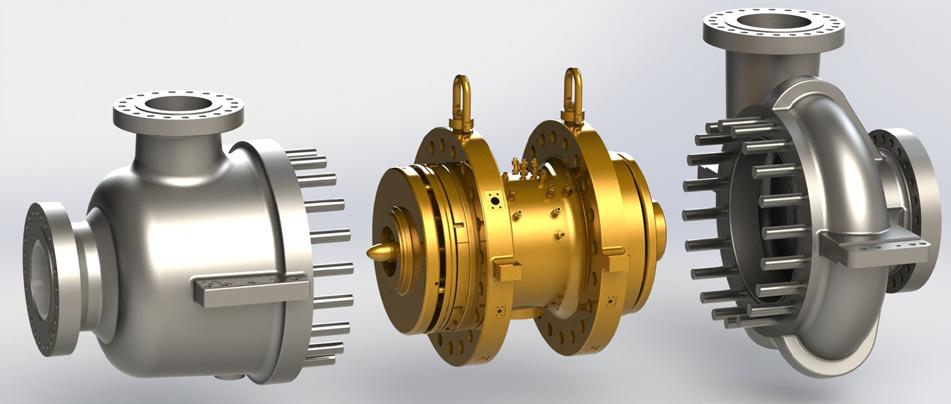
z World-class cycle efficiencies and stable operation realised through the use of compressor-loaded turboexpanders (also known as ‘companders’) for reliable refrigeration across a wide operating range.
z Highly modularised equipment packages enabling reduced field execution scope and faster times to first drop.
Purpose-built process
The AP-N TM LNG Process is Air Products’ nitrogen expander liquefaction process that is used for the company’s small scale LNG product offerings, and currently offers a single-compander cycle and a dual-compander cycle to cover a broad range of liquefaction capacities. Optimised equipment selections are designed to suit small scale LNG plant production ranging from 140 – 450 tpd and higher. This process offers benefits that include:
z High efficiency and reliable turndown capability.
z Simple start-up and shutdown procedures with short cold or warm start-up periods.
z Non-flammable and environmentally benign nitrogen refrigerant that is safe and widely available.
z Low equipment CAPEX and low maintenance cost due to lower equipment and process complexity and well-referenced components.
Productisation – standardisation plus value-added customisation
Adaptability in plant configuration is the basis of the equipment design for Air Products’ small scale LNG product offerings. To accommodate variations in feed gas composition and flow, all static and rotating equipment is designed with flexibility in mind to cover a wide range of operating conditions and production capacities. Furthermore, site environmental conditions and availability of utilities may dictate additional constraints to the equipment selection. By deploying a standardised major equipment set with engineered-to-order performance attributes, customers can realise reduced CAPEX while achieving target capacity.
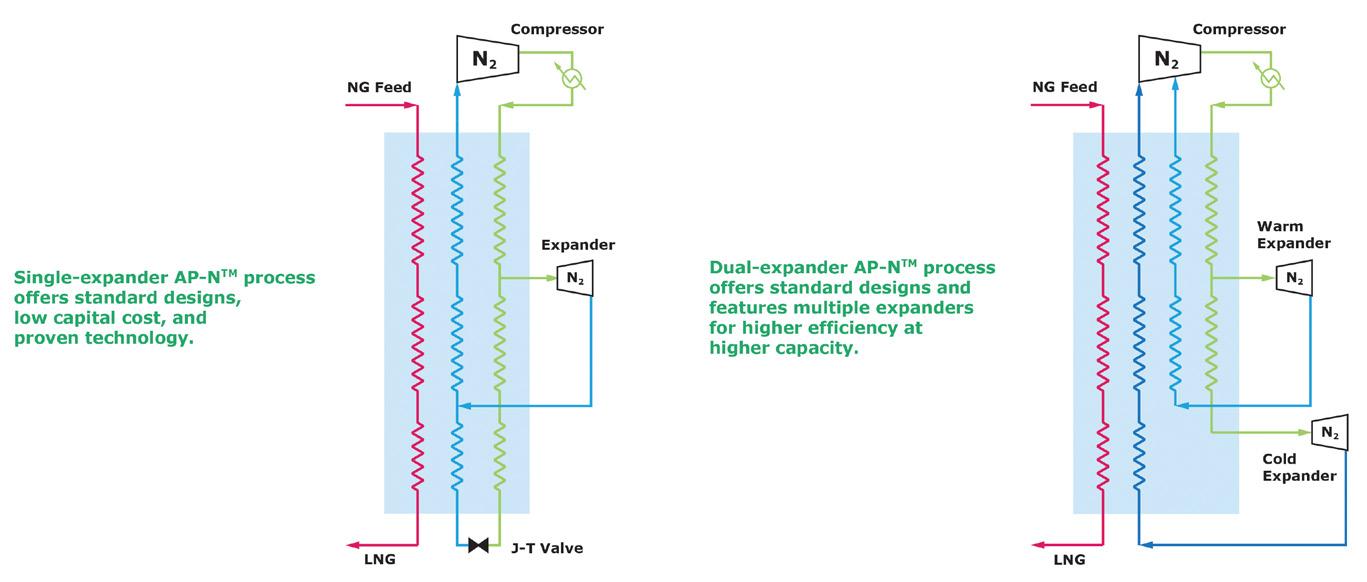
The company takes a meticulous approach to product development, utilising decades of engineering and design experience to successfully productise small, mid, and large scale plants across the air separation and hydrocarbon industry – including natural gas liquefaction. Productised small scale LNG liquefier scope includes a complete, pre-engineered liquefaction system featuring core process equipment and piping runs designed for minimal footprint,
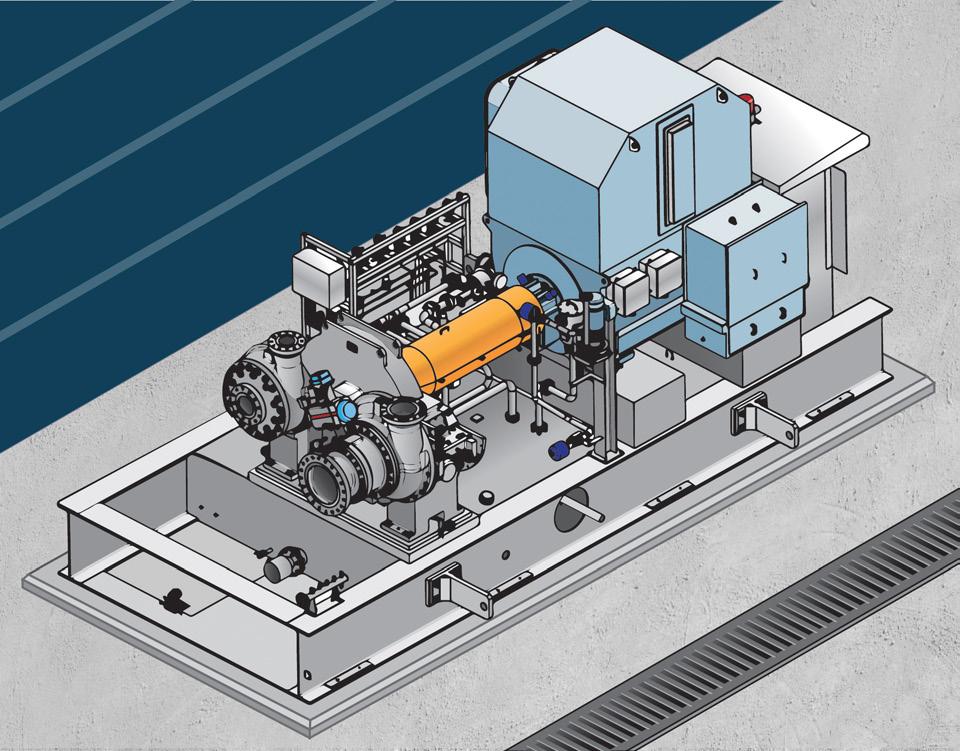
32 North America 2023
Figure 1. Fully packaged integral gear nitrogen recycle compressor enables a high degree of project certainty by reducing field work.
Figure 2. Modular compander rotating assembly designs offer a small footprint and easy maintenance.
Figure 3. The AP-NTM LNG Process presents options to optimise liquefaction over a variety of plant configurations.
low pressure drop, and enhanced plot plan flexibility. Major pieces of equipment include cold box and crossover box, control valve module, nitrogen recycle compressor, and compressor-loaded turboexpander (compander).
Cold box and crossover box
The insulated cold box can be considered the heart of the AP-N process. Its internals include the main liquefaction BAHXs, cryogenic control valves, and heavy hydrocarbon removal drum. The main liquefaction BAHXs are sized to accept a wide variety of feed compositions and ambient conditions. The crossover box provides an insulated duct integrating the companders into the cold box; it also features pre-installed piping and valves for reduced field execution scope.
Control valve module

This pre-packaged module provides safe, convenient personnel access to all non-cryogenic control valves integral to liquefier operation. Keeping all critical valves in one location minimises the time spent making online adjustments or performing offline maintenance. The module also acts as a pipe rack, supporting large-bore piping that runs between the nitrogen recycle compressor and air-cooled heat exchangers.
Nitrogen recycle compressor
Selecting a single compressor frame size with a flexible aerodynamic design enables the product development
team to accommodate a wide range of nitrogen refrigeration duties without affecting critical tie point coordinates. The modular aerodynamics allow the compressor’s performance to be optimised for maximum efficiency for each opportunity, accommodating variations in cooling medium and process conditions.
Compressor-loaded turboexpander (compander)
Air Products’ offerings include the Rotoflow® EC series compander featuring a compact, single-shaft design with adjustable expander inlet nozzles to fine-tune the performance for project-specific conditions. Deploying active magnetic bearings (AMB) and a seal-free mechanical assembly in each EC compander used in a small scale LNG product translates into a small footprint, no lubrication requirement, and zero refrigerant loss from the compander. This hermetically sealed and intrinsically safe design was developed specifically for the LNG industry.
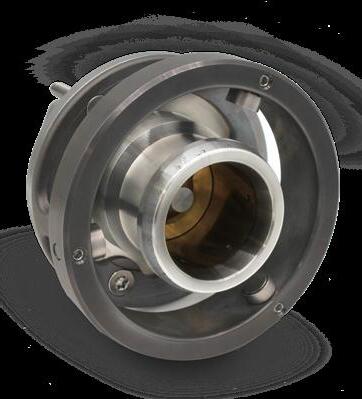
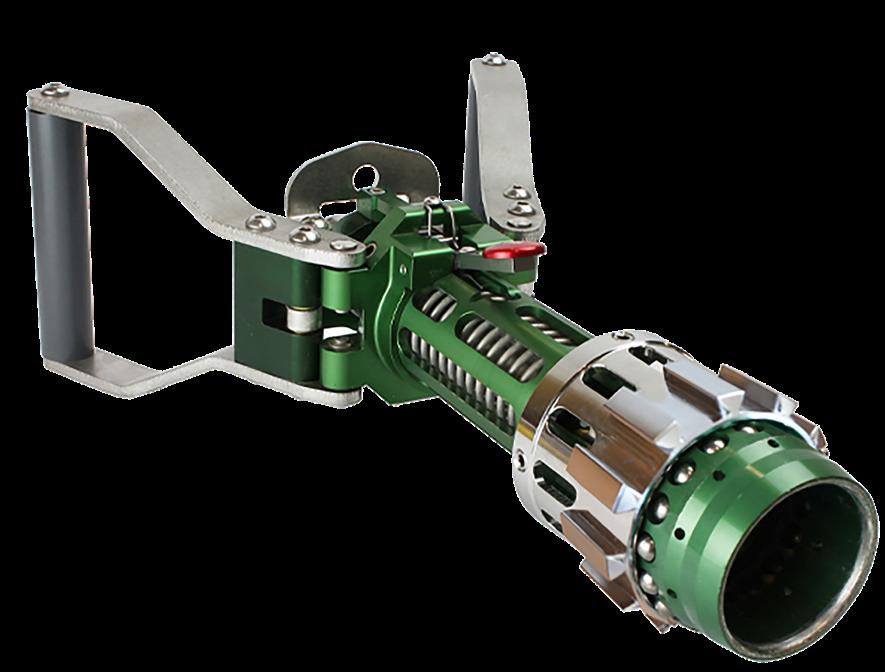

All major pieces of equipment are supplied as either skid-mounted packages, cold boxes, or pre-assembled modules including piping, instrumentation, and valves. This significantly reduces field installation scope and schedule. Cold box equipment is manufactured and assembled in Air Products’ specialised manufacturing facilities around the globe that have supported cryogenic air separation and LNG technology for decades.
The most cost-effective way to transfer cryogenic liquids
Evacuation & Safety Device
Maximum safety for LNG fuel technology
Super-Insulation
The inner and outer pipe is constructed of 300 series stainless steel. Insulation is a low vacuum with multiple layer insulation (MLI).
The comprehensive component design to complete the system design, manufacture, and installation capability.
Maximum service life thanks to these advanced features to produce exceptional efficiencies across the entire system. Cryogenic insulation for Nitrogen, Oxygen, Argon, Helium, Natural Gas, Carbon Dioxide, Hydrogen
“Safety Stop”
Stainless Steel Inner Pipe
SAFE
for added safety and operator protection.
CryoMac® 4 LNG Fueling Nozzle
Patented nozzle
safety
feature
is recognized in the market as a major failsafe advantage for the operator.
DURABILITY
www.regoproducts.com www.acmecryo.com Copyright © 2023 OPW Clean Energy Solutions
Ball cage interface with receptacle adapter ring guides and locks the nozzle in place for optimum engagement and user interface to increase environmental seal life.
þ
Vacuum Jacketed Pipe (VJP)
Safety and environmental impact
The use of nitrogen as a refrigerant yields substantial safety and regulatory benefits compared to hydrocarbon-based liquefaction cycles. Most importantly, the risk to personnel and property due to the flammable nature of hydrocarbons is mitigated. Additionally, the use of a nitrogen-based cycle eliminates the need to control fugitive emissions, thus avoiding costly environmental permit compliance related to refrigerant containment. By deploying oil-free companders, circulating lubricant inventory and storage requirements are dramatically reduced compared to oil-flooded models. This further reduces the site’s lifecycle carbon intensity, while lowering the risk of an environmental release and potentially reducing permitting requirements based on location and agency jurisdiction.
With sources of renewable and decarbonised electrical power such as solar, wind, and hydro on the rise, customers who choose an electrically driven main refrigerant compressor reap the added benefit of future-proofing their liquefaction facility and immediately minimising their
operational carbon impact. For those customers in more remote locations and without access to a local grid or provision for on-site power generation, a gas turbine driver for the refrigerant compressor can be specified; this option opens the door for pre-combustion carbon reduction solutions, such as hydrogen co-firing provided by AP-BlueLNGTM liquefaction technology.
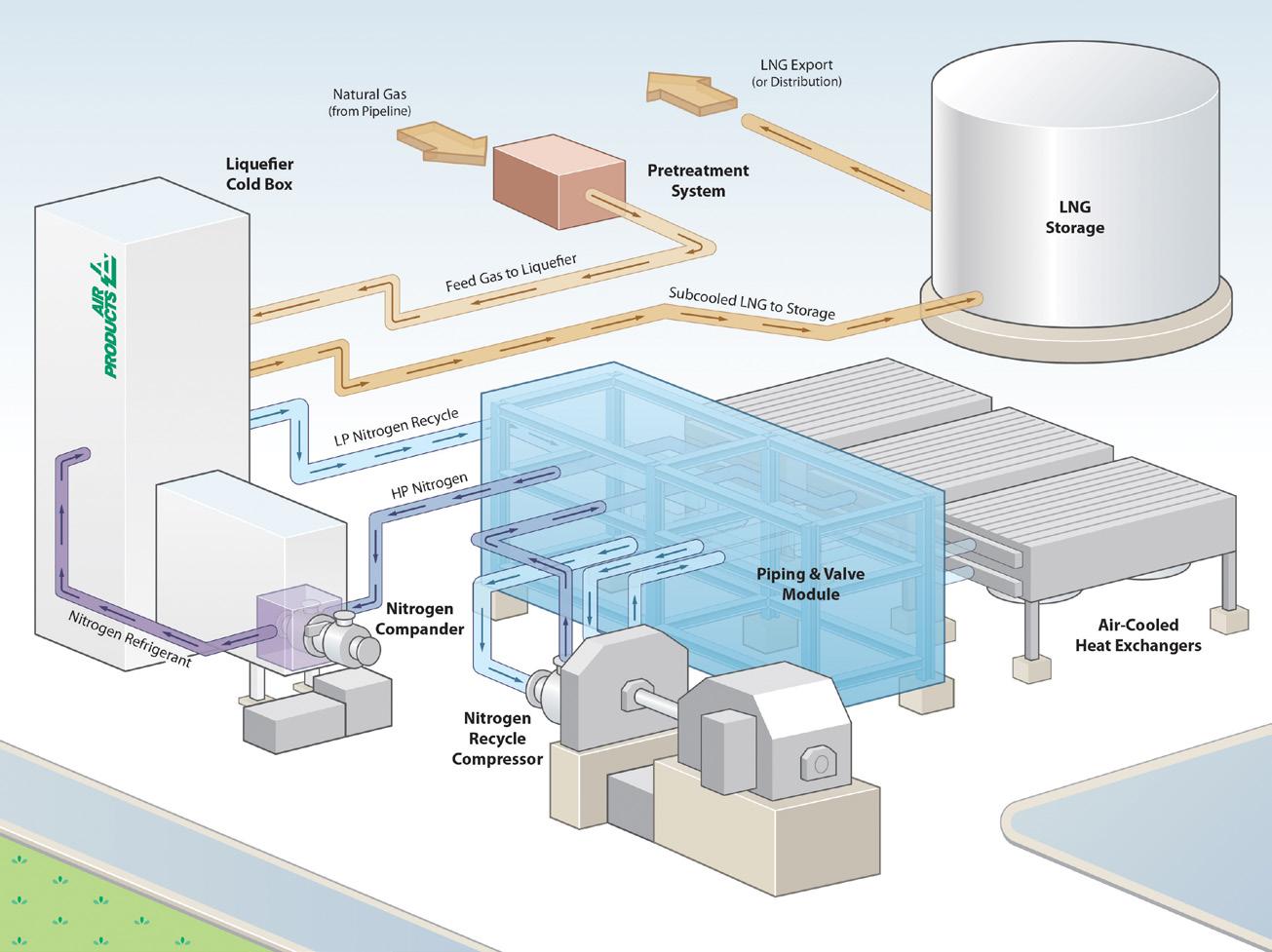
Field support experience – peak shavers
Existing infrastructure and geographic location may present limitations for import capacity during peak seasons. The shift from heavy fuel oil to clean-burning natural gas for heating, combined with residential sprawl from existing city centres into more remote locations, further compounds the challenge for natural gas utilities. Multiple North American small scale LNG facilities that utilise Air Products’ liquefaction technology have been in operation for decades, with the latest onstream as of early 2023. For small scale LNG peak shaving applications, despite the cyclic, seasonal nature of their operation, Air Products-designed liquefiers have proven to be robust, easy to start up, and reliable with high on-stream availability when running.
The most recently commissioned peak shaver featuring the AP-N LNG Process has already proven to be a boon to the reliability of the critical Northeast US residential and commercial grids. Initially established as a liquid import and distribution facility, this plant now has the ability to liquefy gas from the local pipeline during off-peak, warm-weather months and store the liquid to be vaporised and deployed during peak, cold-weather demand.
In addition to the process technology and equipment, initial start up and field support are key to maximising plant efficiency and reliability. Air Products offers extensive field support during the construction, commissioning and start up, and process optimisation phases of each peak shaver’s lifecycle. The small scale LNG product engineering team leverages the comprehensive experience of each site start up to further refine product offerings for improved reliability and user-friendliness. This direct line of feedback shortens the product development cycle and results in the best possible offerings for each customer.
Conclusion
To meet the global demand for LNG, production facilities must be designed with agility in mind to offer options that range from mega scale to small scale liquefiers. Although smaller by nature, small scale LNG marries Air Products’ process and cryogenic technology expertise with the necessary efficiency, reliability, and safety requirements to suit widespread applications and user-friendly operation. In addition, the flexibility of these small scale LNG designs provides options to meet production capacity, variations in operating conditions, and geographic location requirements.

34 North America 2023
Figure 4. A peak shaving facility featuring the AP-N LNG Process, fully equipped with each core system integral to safe and reliable liquefaction.
Figure 5. Cold boxes being manufactured at Air Products’ Caojing manufacturing facility in Shanghai, China.
It would be fair to say that North American LNG is on something of a roll at the moment. The US is set to become the world’s largest producer in 2023, and healthy demand combined with last year’s record prices are acting as strong incentives for new project proposals.
The global LNG industry has certainly come a long way in its lifetime, evolving from inflexible ‘point-to-point’ contracts, through the rise of portfolio players to more variety in pricing. Then US LNG arrived, with a unique model that offered the flexibility of FOB contracts and opened the door for new market participants: the focused LNG developers.
35
Record prices and the need for energy security have created strong momentum in North American LNG. Kristy Kramer, Vice President Gas & LNG Research, and Sean Harrison, Research Analyst Gas & LNG, Wood Mackenzie, explore why a focus on addressing potential issues with the contracting, financing and construction of projects will be important to keep the healthy project pipeline on track.
However, with competition leading to reduced liquefaction fees and costs rising, the industry is once again innovating to create a new recipe for North American LNG. New value chain participants (in the form of North American energy companies), shorter contract terms, and evolving financing approaches are just some of the ways the sector is advancing to adapt to the new environment.
Project outlook
There can be no doubt that the current North American LNG project pipeline is extremely healthy. Already in 2023, Sempra’s Port Arthur LNG and Venture Global’s Plaquemines LNG Phase 2 have been sanctioned, adding 20 million tpy of new capacity.
Since 2021, buyers have come back to long-term deals, committing to developers to support new projects; 65 million tpy of long-term contracts were signed in 2022 alone, dwarfing the 18.5 million tpy of new capacity confirmed in the previous year.
Looking forward, a challenging geopolitical environment is emphasising the strategic priority for energy security. As a result, a key concern for buyers is accessing supply that can be delivered quickly and reliably. With respect to speed to market, North American LNG projects are well positioned compared to LNG developments in the rest of the world because they are advanced (both in terms of permitting and contracting), and have access to supply and an experienced labour force.
In total, over 80 million tpy of capacity is under construction across North America. Several other projects are FID-ready, being fully permitted, with EPC contracts signed or under negotiation, and around the contracted offtake thresholds required for raising debt.
Wood Mackenzie’s analysis indicates there is the potential for between 90 million tpy and 250 million tpy of new North American LNG capacity to be brought online before 2030 (including projects already under construction and pre-final investment decision [FID] projects). Overall, over US$125 billion is proposed to be invested in North American projects in the next five years.
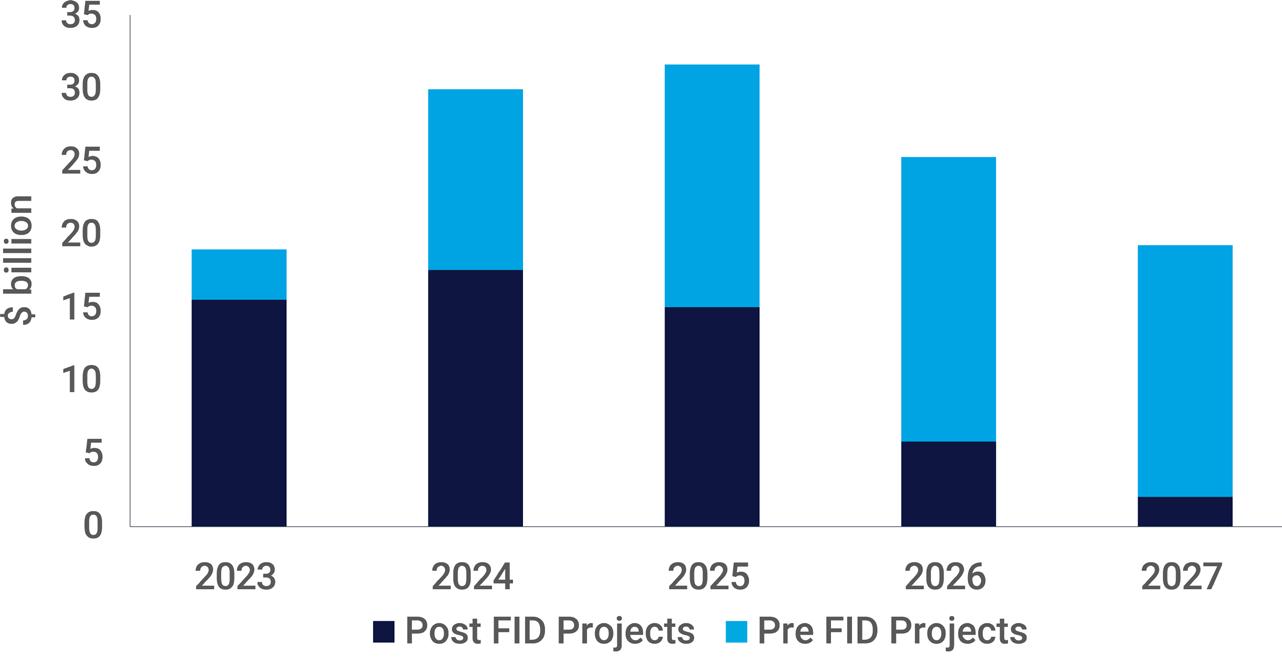
However, the road from initial proposal to functioning facility is a long and complex one, with a number of factors involved in a project getting to FID, then making its way through construction to start-up. With this in mind, industry stakeholders need to take a structured approach to navigate the changing market environment, minimise the risks and maximise upside from projects.
Contracting trends
While record contracting is driving an undeniably strong pipeline of North American LNG projects, Wood Mackenzie’s contract database and liquefaction fee benchmarking shows that competition between US developers to access buyers has kept fixed fees low over the past five years, despite rising project costs. As shown in Figure 2, while liquefaction fees have risen very slightly since 2020, current fees of US$2.00 – US$2.50/million Btu are lower than those seen over a decade ago.

On the plus side, contracting has been buoyed by new entrants seeking access to LNG capacity – largely North American upstream and midstream players looking to diversify their portfolios and access highly attractive international LNG prices. These new entrants have joined an already busy marketplace populated by legacy and returning buyers seeking the relative security and predictability of long-term offtake agreements.
Some upstream and midstream players have agreed capacity positions (such as ARC Resources with Cedar LNG, Devon Energy with Delfin Midstream, and Williams with Sempra), while others have signed LNG-priced gas sales agreements (most notably 3.4 million tpy such sales agreed with Cheniere), and some have also taken equity in projects (including ConocoPhillips at Port Arthur LNG, and Enbridge at Woodfibre LNG). Wood Mackenzie expects midstream and upstream players to continue to seek further access to North American capacity, and so with legacy and returning buyers remaining in the market, contracting momentum throughout 2023 will likely be sustained.
Construction costs
As new projects proliferate, construction costs are increasing. Finite resources mean soaring
36 North America 2023
Figure 1. Potential investment into North American LNG projects 2023 – 2027, by FID status. Source: Wood Mackenzie Lens Gas & LNG.
Figure 2. Current average US liquefaction fees are below US$2.50/million Btu. Source: Wood Mackenzie Lens Gas & LNG.


NORTH AMERICA A supplement to LNG Industry LNG Industry will be in Vancouver! Visit us at LNG2023Booth 804 Distributed at
demand for both manpower and services is likely to outstrip supply. As a result, current EPC prices are around 15% higher than those agreed for projects sanctioned over the previous three years (Figure 3). With costs high, projects are having a harder time even reaching construction.
Lowering the CAPEX requirement for projects is therefore vital not just to improve margins, but to ensure the viability of projects. Reducing timelines by staggering the use of resources across projects sites can help, as can piggybacking off existing facilities and/or using common elements. Examples include Cheniere’s Midscale Trains 8&9 project at its Corpus Christi LNG facility, which is set to get a head start via previous construction for its Stage 3 project, and Venture Global’s Plaquemines project replicating the design used at its Calcasieu Pass facility.
Financing challenges
With EPC costs rising faster than liquefaction fees, US LNG margins have been getting squeezed. In the current economic environment, the rising cost of borrowing is a further issue. For example, debt financing for Sempra’s Port Arthur LNG Phase 1 project was agreed at 2% above SOFR, which at the time of writing equates to 6.5%.
With unlevered internal rates of return (IRRs) on some projects as low as 5 – 6%, higher borrowing costs threaten overall profitability. As a result, some projects are finding it challenging to secure finance from both the debt and equity markets.
By selling part ownership of a project to a third party, or even to customers, developers can share the burden of risk involved and increase the probability of a project’s success. Sempra has pursued this strategy at Port Arthur, successfully closing an agreement with customer ConocoPhillips to take a 30% stake, as well as offering a 25 – 49% indirect, non-controlling interest to leading global investment firm, KKR. It should be noted that maintaining a controlling interest and access to the potential economic upside from factors such as higher spot prices or unlocking additional capacity is an important element of any such arrangement.
Finding the upside
With returns tight, developers need to seize every opportunity to ensure project viability if current momentum in the LNG sector is to be maintained. Ensuring the best possible package of buyers, construction approach, and financing is essential to get projects through FID, and ultimately on to operational profitability.

In terms of financing arrangements, projects are normally expected to derive around 70 – 80% of finance from debt markets. However, with borrowing costs so high, Sempra adapted by raising nearly 50% of the funding for its Port Arthur LNG Phase 1 project from equity financing, an approach Wood Mackenzie expects other developers may try to replicate. The company also innovated by offering buyers deals with a 15-year tenor (as opposed to the 20-year deals available from other projects). This move helped attract highly creditworthy European buyers, who were seeking security of supply in the wake of the Russian invasion of Ukraine.
In terms of project economics, there are several actions developers can take. One way of making projects more financially viable is by increasing production levels; rerating trains for higher capacity, debottlenecking, and adding expansion trains can provide opportunities to increase production in the future if demand is there.
Margins can also be improved through more efficient feed-gas procurement and plant operations; for example, losses in liquefaction before the FOB point can potentially be reduced to below the contractual benchmark of around 15%.
There is also potential for huge upside from the sale of cargo onto the spot market, if delivered into a buoyant price environment. Venture Global has taken advantage of this at Calcasieu Pass, where supply and purchase agreements (SPAs) linked to the project only commence once Venture Global declares the facility ready for commercial service. Given record prices last year, Wood Mackenzie estimates it made up to US$8 billion from these sales in 2022 alone. Related, a further potential source of additional returns is through going uncovered on more capacity and so retaining access to the potential upside from global commodity prices via the export market.
Finally, it is worth mentioning that the increasing focus on decarbonisation provides opportunity through reducing emissions. Some developers, including NextDecade, Sempra, and Venture Global, have proposed carbon capture and storage facilities as they look to reduce their projects’ environmental impact. US producers are also doing their part; the volume of gas classified as responsibly sourced gas, where it is certified to have comparably lower emissions, tripled during 2022 to reach 26 billion ft3/d. As the energy transition continues, these initiatives will keep North American LNG attractive for buyers and could allow developers to charge premiums to customers.
Conclusion
With the economic and commercial landscape changing, North American LNG is evolving to meet a new set of challenges around contracting, financing, and construction. Rising costs and squeezed margins point to the likelihood of an increase in liquefaction fees, as well as to continued innovation in financing. And while contracting trends suggest that proven developers are best positioned to exploit the opportunity through expansion and follow-up projects, new entrants with the right skills and resources to succeed are also likely. By being proactive in relation to industry challenges, the current momentum in the sector can be maintained and even increased.
38 North America 2023
Figure 3. US LNG plant CAPEX costs are rising. Source: Wood Mackenzie Lens Gas & LNG.
ustody transfer refers to the process of transferring ownership and responsibility of a product or commodity from one party to another. It involves the transfer of physical possession, as well as the associated rights and obligations related to the product. Custody transfer is commonly applied in industries such as oil, gas, petrochemicals, and utilities, where the accurate measurement and verification of quantities and qualities of the transferred material are crucial for commercial transactions andaccountability.
In the context of LNG, custody transfer specifically involves the transfer of ownership and responsibility of LNG from the seller to the buyer. It encompasses the accurate measurement of the quantity and quality of LNG being transferred, typically at loading terminals, storage facilities, or during ship-to-ship transfers. Custody transfer ensures transparency, accuracy, and fairness in commercial transactions by providing a standardised process and reliable measurement systems to determine the value and quantity of the transferred LNG.
It is important to note that the specific details and procedures of LNG custody transfer may vary depending on the parties involved, contractual agreements, regional regulations, etc.
Current standards
LNG custody transfer is based on the GIIGNL Custody Transfer handbook 6 th edition and ISO 8943: 2007.
The ISO 8943: 2007 is focused on the quality of the

39
Hans-Peter Visser, Analytical Solutions and Products B.V., the Netherlands, outlines the needs for fully-automated LNG custody transfer measurement systems.
LNG by means of composite sampling and on-line (gas chromatograph) analysis, while the GIIGNL has it overall coverage. The GIIGNL advise also how to determine the quantity of the LNG transferred which is done by means of gauging.
Gauging is a manual procedure, taking in account various measured physical properties and process parameters, consulting tables, and the need for a highly-skilled and experienced surveyor. This is a labour-intensive, time-consuming and costly process where accuracy and reproducibility depend on the quality of the surveyor. Everyone knows that one surveyor is not like another surveyor, and that even the best surveyor has a bad day. In other words, there is a human error factor which may impact the determination of a high US dollar value of an LNG cargo.
More and more end-users, especially in the US, are requesting a fully-automated LNG custody transfer
measurement system. This includes automated time and flow proportional LNG sampling according ISO 8943 as well.
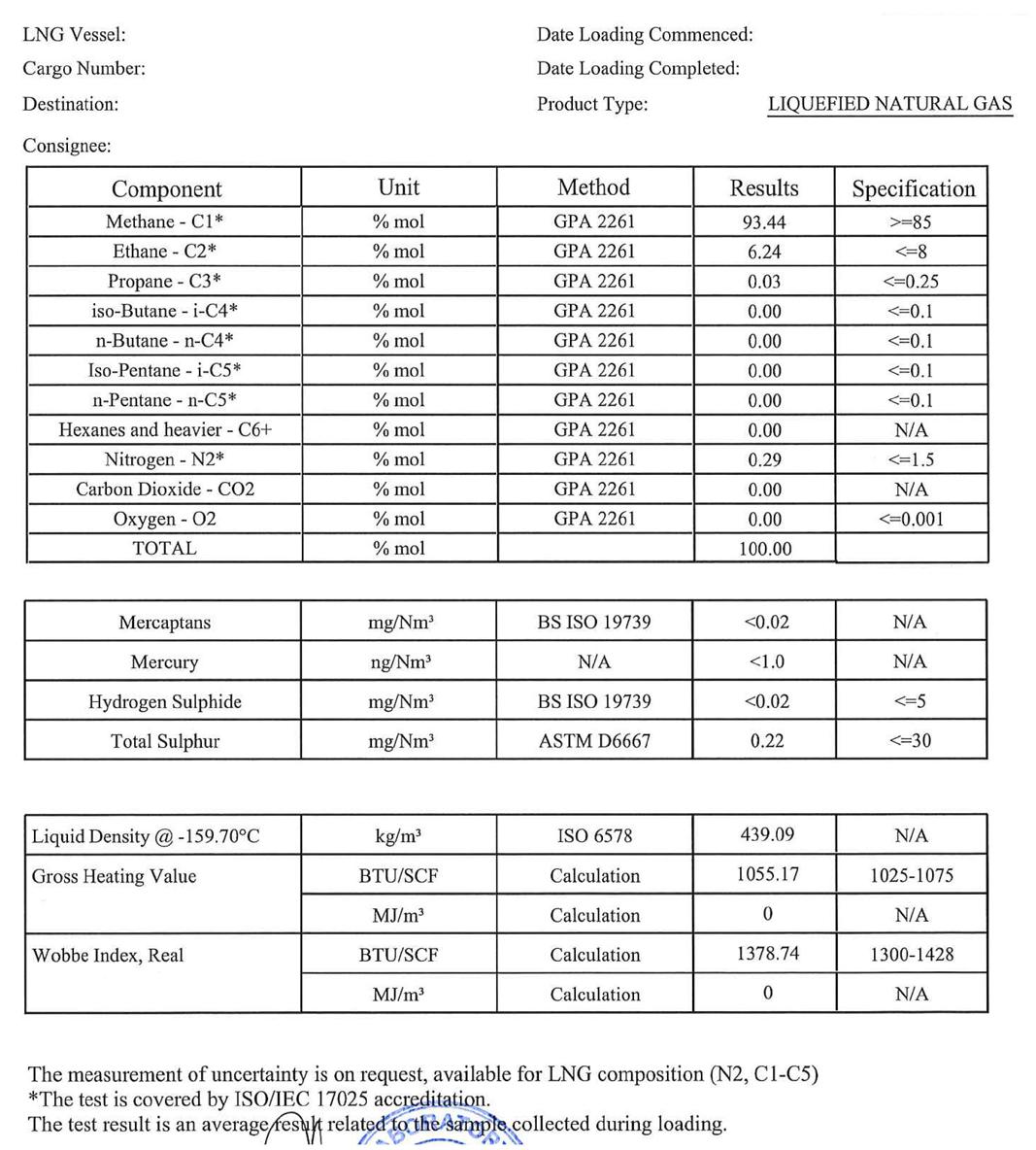
EPC contractors require the same, including integration of the whole the system to a compact skid with clear battery limits. Their benefit is to have just one single point of contact for project execution, commissioning, and start-up.
The need for in-line flow measurements and metrological traceability
With the current technology in place, it is possible to measure the flow of LNG either via Coriolis flow meters or Ultrasonic flow meters.
The major challenge for LNG flow meters was metrological traceability and how to determine the accuracy of a LNG flowmeter. Based on studies and tests, there was the assumption that there was a correlation between LNG and water measurements for LNG, which is currently used in the market. Recent tests show differently; to be sure that LNG flow meters measure correctly during use, they need to be calibrated at cryogenic conditions with LNG. Recently, a new standard – ISO 21903:2020 – was published by the International Standards Organisation (ISO), to specify the metrological and technical requirements for flow meters that can dynamically measure LNG and other refrigerated hydrocarbon fluids.
VSL’s calibration and test facility for LNG flow meters
In March 2023, the Dutch National Metrology Institute VSL (re)opened its brand-new European Center for Flow Measurement on the Rotterdam Maasvlakte in the Netherlands. This unique test facility includes the LNG calibration and test facility for LNG flow meters for mass and volume at cryogenic conditions with LNG. VSL can determine any output signal utilising the master meter method of calibration. This calibration facility is traceable to the National Standard of the Netherlands, has a low measurement uncertainty (CMC), and is currently the only one in the world. All flow meter calibrations of VSL, including LNG, are well accepted around the world. Until now, the maximum flow meter size was 8 in.

Currently, for custody transfer measurement systems of LNG, several dynamic measurement systems are already delivered, installed, and in successful operation. Typical applications are LNG run-down line measurements and LNG allocation measurements.
The flow meters are typically built on so-called skids where nowadays also the complete quality package can be integrated, such as the LNG probe/vaporiser, the online quality measurement, and the composite sampling.
The market requests more and more, especially from the US, for complete custody transfer measurement systems (CTMS), with ultrasonic flow meters up to 36 in. Measurement systems are available now, including the complete analysis and sampling part.
40 North America 2023
Figure 1. Anonymised quality certificate.
Figure 2. VSL LNG test facility in the Netherlands.
It is even possible to integrate the analysis and sampling of both the cooling line and boil-off gas (BOG) return line to created a complete energy transfer equation. The challenge for large size LNG flow meters is how to calibrate these.
Continuous improvement of analytical measurement and sampling of LNG

With an average production of more than 20 LNG quality measurement and sampling systems per year, ASaP belongs to the top of value providers to LNG customers and end-users.
As a market leader, the company sees it as its obligation to the market to continuously innovate and to answer every analysis and sampling related question for every cryogenic application properly and effectively. In-depth application and system knowledge, combined with extensive field experience, creates more and more insights and value to those using the company’s systems.
In May 2022, an article was published in LNG Industry about the right way to measure and sample in a cost effective and accurate manner. The purpose of this article was to outline the importance of continuously ensuring the proper operation of the analysis and sampling systems, and obtaining the highest available accuracy possible for high US dollar LNG cargo values.
ASaP’s proprietary software, Analysis Information Module (AIM), is multifunctional. Its functions include the CTMS operating and control system, the online and continuous performance monitoring system, and the maintenance optimiser. It automatically generates both the cargo quality certificate and the Bill of Lading. If these two important documents are generated automatically, there is a guarantee that the measurements and calculations are matching the LNG cargo characteristics for 100%.
A new feature in AIM is the online generation of the LNG phase envelope. The phase envelop is determined by the measured process pressure and temperature near the sample take off probe, and the measuring results of the gas chromatograph downstream from the sample take-off probe. Based on the phase envelope and the sample take-off conditions, the degree of sub-cooling can be determined continuously and online.
As specified in ISO 8932: 2007, a sample must be taken at the highest possible degree of sub-cooling. Until now, it was not possible to determine the actual degree of sub-cooling. However, developments in software, like AIM, can give an update of the degree of sub-cooling every 10 seconds.
Recently, the value of the new feature of online phase diagram of LNG project determination became clear to a number of users. During the start-up of an LNG factory, it was assumed that the LNG transfer line was completely
filled with LNG and that measurements were being carried out correctly under the right conditions.
However, due to the start up, there was a two-phase situation in the transfer line, which made the analysis results invalid. Further investigation learned, based on the AIM software, that the extraction sample probe was not installed at one of the LNG sample points at the shipyard.
Being aware of this flaw, a new extraction probe could be manufactured and installed on time. If the installation of the sample extraction probe had not happened at this time, the next opportunity would have been five years later during a maintenance shutdown. During these five years, the analysis and sampling results would not have been correct. Due to the standard feature of the online phase diagram determination, this measurement error with a huge financial impact has been prevented.
Added value of small scale (bio-)LNG (truck) loading facilities
In Europe, the use of sustainable bio-LNG becomes more and more common as fuel for trucks and ships. Also, these small installations have to measure the quality and quantity delivered.
For small scale LNG installations, the initial cost for measurement and sampling equipment has a significant impact on the overall plant construction costs. Therefore, a creative approach was required to fulfill all measurement requirements.
At the end of the day, all requirements are met and the first installations are in operation successfully. Some installations have both a truck weighing scale and an LNG end-product flow meter installed for automated custody transfer. Soon, a programme will start where the correlation between the absolute LNG mass delivered and LNG flow delivered will be determined. The results of this correlation programme may add a significant contribution for large scale LNG custody transfer measurement systems.
Conclusion
Fully automated custody transfer measurement systems are available but are limited by the LNG flow meter sizes due to their calibration. Meanwhile, various correlations tests are planned to obtain the uncertainly and traceability data of large LNG flow meters.
North America 2023 41
Figure 3. AIM overall and detailed performance monitoring dasboard
Commonwealth LNG Founder and Chairman, Paul Varello, and the company’s President and CEO, Farhad Ahrabi, took different paths on the way to leading the organisation developing an 9.3 million tpy LNG export facility now nearing final investment decision in Cameron Parish, Louisiana. But when their personal journeys converged in early 2022, both realised a common theme had reverberated within them throughout their highly successful careers – the importance of instilling a positive company culture.
Internally, that emphasis is woven throughout the fabric of
Commonwealth’s organisation, from the genesis of the privately-owned company’s name and branding to its talent strategy and performance culture, and ultimately, in its selected approach to designing – and soon building and operating – an LNG export terminal.
Externally, it involves integrating with the culture of the local community. Southwestern Louisiana continues to be shaped through a shared heritage, a resilient bonding in the aftermath of devastating hurricanes, and a transformative future as the epicentre of the LNG industry, with its associated growth in job

opportunities, tax revenues, and added resources to rejuvenate the region.
An inspiring mentor
Varello, whose career now spans more than 50 years in energy-related engineering and construction projects, credits much of his focus on culture to the lasting influence of an early mentor, Buck Mickel, who served as Chairman of Daniel International when Varello joined as a young engineer.
Varello especially remembers Mickel’s habit of writing notes to employees on his personal notepads. “They were always written in
42
Lyle Hanna, Commonwealth LNG, USA, details the creation of the Commonwealth LNG project, and the benefits it can deliver to the local and wider communities.
red ink, and we fondly called them ‘red bullets’,” said Varello. “They were always custom, specific, and encouraging.”
When Mickel passed away in 1998, Varello returned to South Carolina to attend the memorial service to silently thank him for 25 years of ‘red bullets’, something almost everyone in the church were also recipients of.
Those indelible impressions from Varello’s early career are directly reflected in today’s Commonwealth LNG as he continues to make it a point to encourage all those under his leadership. The company’s logo, on display at Houston headquarters and

43
signage at the 405-acre project site in Cameron, Louisiana, prominently features a red stylised ‘C’, specifically designed as an homage to its ‘red bullet’ heritage.
Varello was equally intentional in the choice of the Commonwealth name for this LNG company formed in 2014 when he acquired the development assets of Waller Marine. From the outset, Varello implemented a performance and compensation system where employees would realise significant shared rewards based upon the company’s success.
Building the team
To help ensure that success, the company has built a team steeped with global LNG experience. The initial employees
were enticed by the cultural vision and the freedom and motivation of developing an LNG export facility to help address a global structural supply deficit projected to reach more than 70 million tpy by 2030. Much of the demand growth is driven by increasing gas demand in China, India, and other emerging Asian countries as they switch away from coal and continue to industrialise. Meanwhile, many European nations are moving swiftly to increase regasification capacity and are likely to require flexible LNG volumes over the medium term to replace gas supplies previously provided by Russia.
Commonwealth’s approach quickly centred around a highly modularised design, with the advantages it could achieve in shorter schedule and time-to-market, as well as reduction in capital expenditure requirements.
These employees were instrumental in helping the company identify others with similar characteristics and values as it built out its supporting functions and advanced the project through FEED and obtaining the project’s Federal Energy Regulatory Commission (FERC) Certificate of Authorization in November 2022.
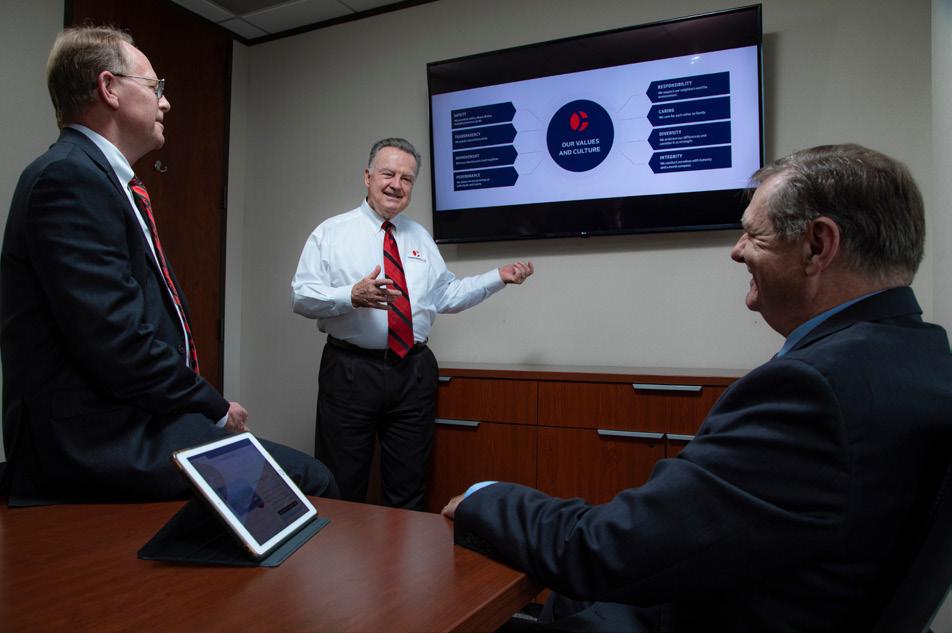
Expanding the C-suite
As the project was advancing through these key engineering and permitting steps, Varello made another significant move in bringing on Farhad Ahrabi, Former CEO of Cameron LNG, to serve as Commonwealth’s new President and CEO in April 2022.
During Ahrabi’s seven-year tenure at Cameron LNG, he had overseen the development, construction, and subsequent operations of a 14.5 million tpy LNG facility in Hackberry, Louisiana.
As Varello noted at the time, “The depth of Farhad’s leadership experience, both at Cameron and the preceding 28 years with BG Group, will be of immeasurable value to our team as we move through the final stages of development and into construction and operation.”
For his part, Ahrabi pledged to “lead the organisation in delivering its promise in a way that not only serves the interests of this company, its employees, the local communities and all other stakeholders, but is part of the overall advancement of the next generation US LNG facilities.”
Those in and around the Commonwealth LNG organisation quickly learned the two leaders were very much aligned in their mission of fostering a superior company culture. In one of his earliest ‘Conversations with Employees’ communications, Ahrabi reminded the Commonwealth team about how company culture impacts their collective legacy, with the success or failure depending on it.
Ahrabi explained that the company must be deliberate in developing and cultivating its desired culture by walking the talk at all times inside and outside of the workplace: “It is the one thing that will ensure we attract the best employees and retain them, and it is the only thing that will help us navigate our most difficult challenges throughout this journey that we are all on.”
A culture shield
In addition to the company’s previously inspired ‘red bullet’, Ahrabi would contribute the visual imagery of a ‘culture shield’. A graphic with the core values of the company incorporated on a shield are prevalent within Commonwealth’s offices.
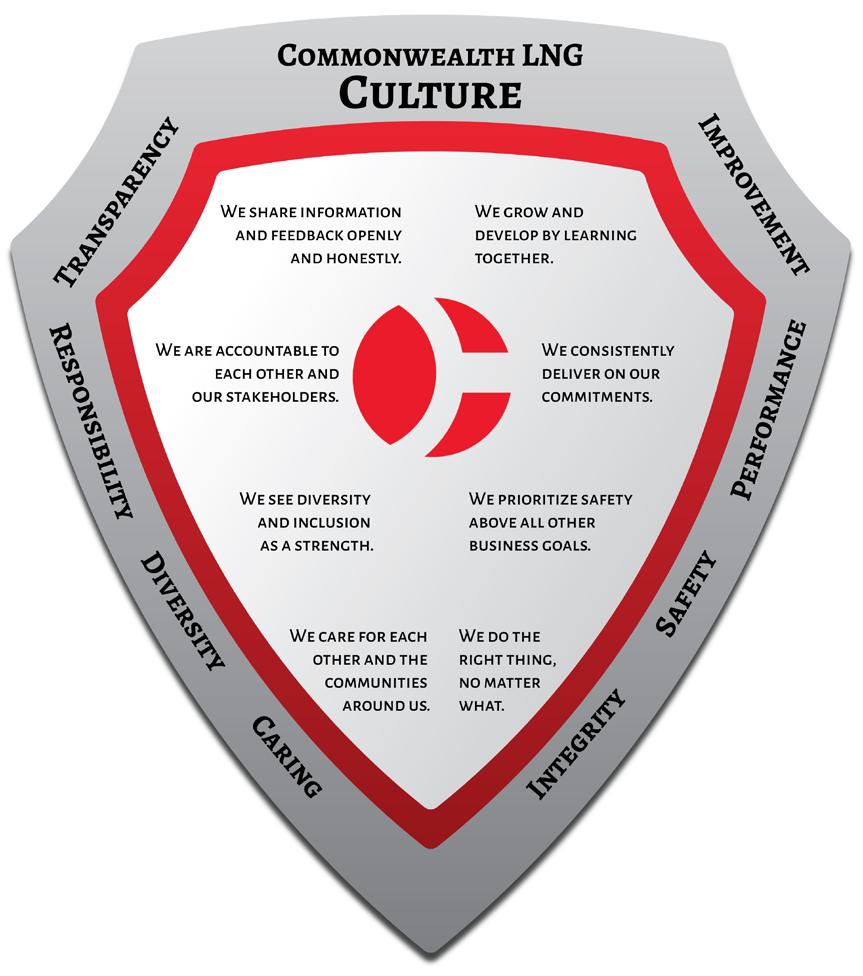
44 North America 2023
Figure 1. Commonwealth LNG Founder and Chairman, Paul Varello (centre), has emphasised a positive company culture throughout his career spanning more than 50 years as a leader in engineering and construction. Early hires at Commonwealth included experienced engineers Erik Jansson (left) and Jonathan Allcock.
Figure 2. Components of the Commonwealth LNG company culture are graphically depicted on a shield. This image, posted prominently in the company’s conference rooms and common areas, provides a constant reminder of these tenets to the employees who work there. Note the ‘red bullet’ in the Commonwealth LNG logo which honours a heritage of recognising employee contributions.
The culture defines the company and how it goes about business, and it needs to be leadership enabled, and employee led. It is the culture that shields the company during its most challenging times – an organisation’s culture is either one of its strongest assets or one of its biggest inhibitors of success.
Commonwealth is already taking steps to address one of the foremost challenges – maintaining its cohesive and positive culture through the stages of significant growth and development. Increasingly, many of the company’s engineering employees spend most of their working hours at the headquarters of engineering partner Technip Energies, a world leader in modular facilities.

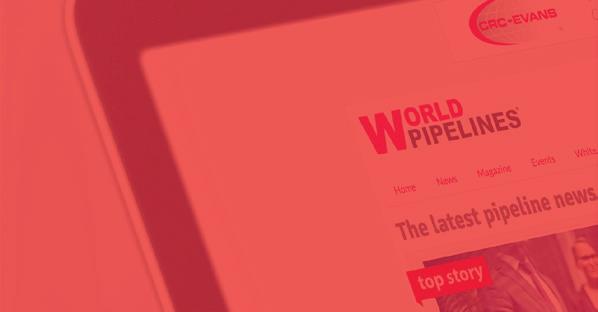

In the coming months, Commonwealth will begin its on-site work in Cameron. Even with most workhours completed in off-site fabrication shops, Commonwealth anticipates the construction team on site to reach approximately 2000 workers at peak, averaging approximately 800 overall during the 36-month construction period.
The forecast of a robust market in LNG and other Southwestern Louisiana industries is certain to intensify competition for available skilled labour in the region. Commonwealth believes it can attract the best of this talent through a combination of opportunities to work with an efficient technical design and a culture that makes the work experience enjoyable and attuned to work/life balance.
Varello and Ahrabi are resolute that the emphasis will remain the same: Vision is the visible structure, while culture is the foundation that is essential is supporting that structure above itwhile it is completely out of sight.
i



A shared purpose: Creating a legacy
Varello and Ahrabi are mindful that a positive culture cannot simply be imposed upon an employee population. Trust is earned – first and foremost – through modelled behaviour. Beyond the scope of daily activities, accomplished people and organisations have the opportunity – and arguably the responsibility – to consider their legacy.
Both recognise that most people need to feel that they are a part of something bigger than themselves. Developing and operating a multi-billion-dollar LNG export facility can be a crowning achievement in many team members’ careers. Further contributing to the satisfaction is the element of bringing the cleanest American fossil fuel to the world and enhancing energy security for many locations and introducing a catalyst for growth in emerging economies.
Locally, Commonwealth and other nearby LNG facilities are revitalising the economy of a battered but unbroken region. Cameron Parish is the largest parish by area in Louisiana, but it has the second-smallest population in the state with just around 6000 people.
Varello and Ahrabi continue to enhance Commonwealth’s culture by finding more ways to motivate employees to bring out the best in themselves and others – maximising creativity, productivity, and, above all, safety. They look forward to not only the satisfaction of seeing their current LNG export terminal come to fruition, but to do so in a way that may inspire others to achieve similar shared experiences and ambitious goals that would exemplify the Commonwealth legacy at its best.
ebsite Visit our website today www.worldpipelines.com The home for the latest pipeline news, analysis, comment and events
Pipeline
ndustry w
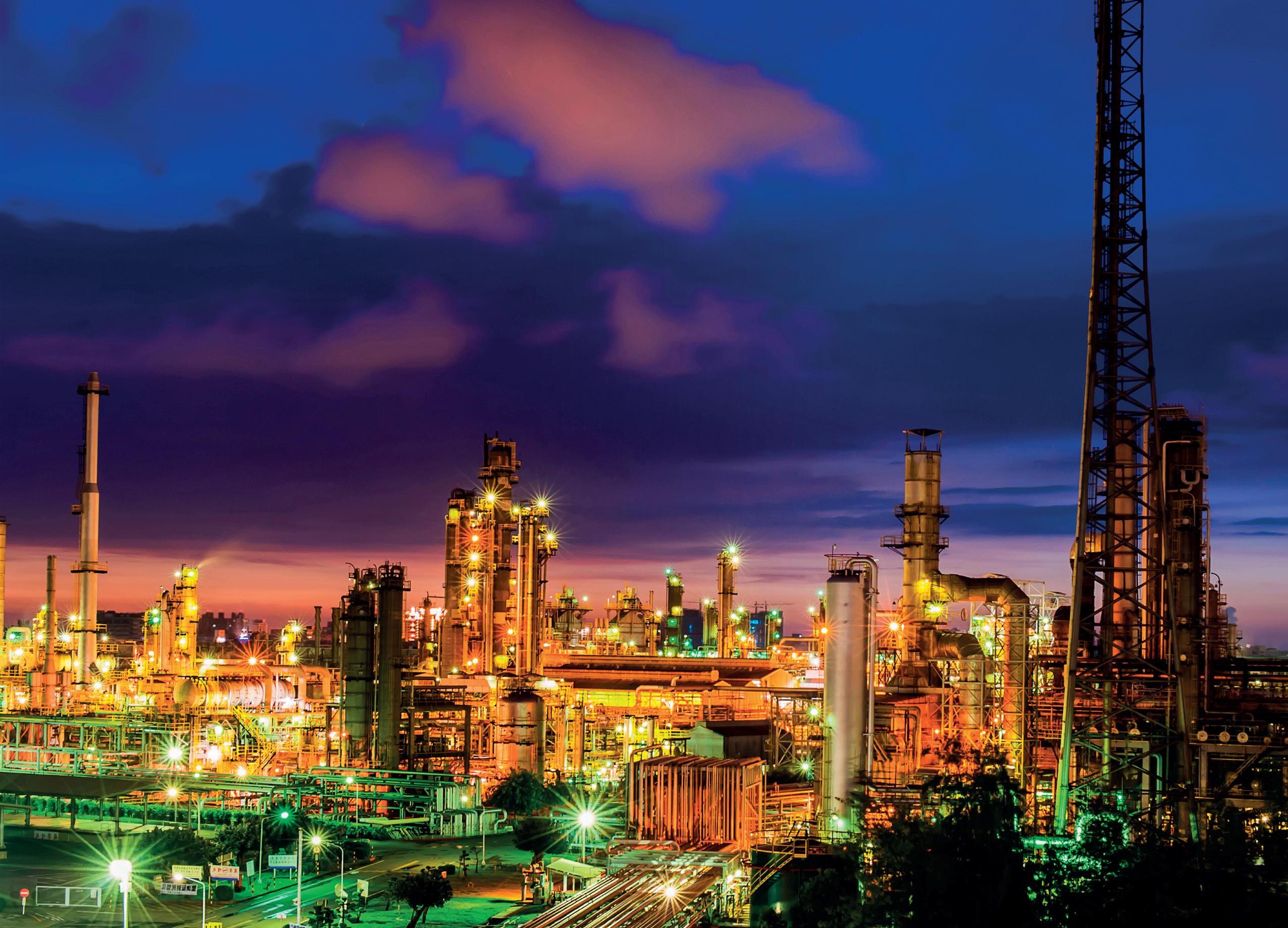


















Subscribe online at: www.hydrocarbonengineering.com/subscribe Worldwide Coverage For in-depth coverage of the global hydrocarbon processing sector
In February 2022, leaders of the Alaska Gasline Development Corporation (AGDC), the team behind the Alaska LNG Project, prepared to travel to Houston for the annual CERA Week energy conference. The Alaskans packed presentations and scheduled meetings to explain the climate benefits of Alaska LNG, consistent with the national energy strategy laid out by the Biden Administration.
The Russian invasion of Ukraine, just a few days before the conference, turned their plans upside down.
Immediately following the invasion, international interest in Alaska LNG skyrocketed. Alaska LNG was in the catbird seat when LNG investors realised that buyers in Asia would quickly need to find new sources to replace natural gas from Russia and North American LNG being diverted

Timothy Fitzpatrick, Alaska Gasline Development Corporation, looks at how shockwaves from Russia’s invasion of Ukraine propelled the Alaska LNG project to the forefront of new LNG developments.
47
Figure 1. Alaska LNG is the only fully-permitted US West Coast LNG export project, opening direct US access to major Asian energy markets.
to Europe. The advantages of Alaska LNG’s close proximity to Asia rapidly came into focus as developers examined the prospects of new LNG projects.
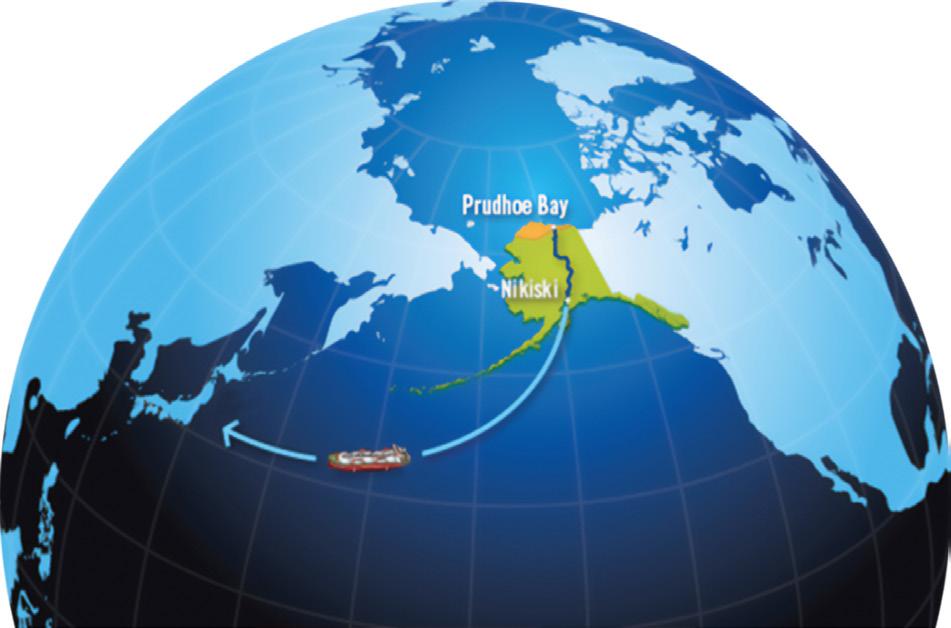
As recalled by AGDC President, Frank Richards, the company became the ‘belle’ of the CERA ball overnight, with potential partners lining up to talk as a result of it being the only export project on the US West Coast with all major permits in hand. Industry insiders knew the conflict in Europe would create an energy vacuum in the Pacific.
US officials have watched Europe’s growing dependence on Russian energy with concern for years. Prior to the invasion, 40% of Europe’s natural gas originated in Russia. European energy buyers pivoted to the US and other allied LNG suppliers for relief.
The morning after the Russian invasion, Asian energy leaders faced a two-fold crisis. First, Europe’s skyrocketing demand for non-Russian LNG immediately drove global LNG spot prices to record-breaking, astronomical heights. Second, due to their proximity to and reliance on energy from Eastern Russia, Asian nations were staring down the same geopolitical energy vulnerabilities being experienced by European nations.
Energetic US federal support
The ongoing global energy reckoning has also strengthened US federal support for Alaska LNG. The federal support for this project has grown to the point where it now mirrors the strong stakeholder and community backing found within Alaska.
The Bipartisan Infrastructure Law, signed by President Biden, made Alaska LNG eligible for Federal Loan Guarantees which are indexed to inflation, helping mitigate post-pandemic and invasion-related price changes. These loan guarantees, spearheaded by US Senator, Lisa Murkowski (Alaska), are currently worth US$29 billion and backstop more than 65% of the project’s costs.
The U.S. Department of Energy (DOE) amended record of decision and supplemental environmental impact statement (SEIS) issued for Alaska LNG by the Biden Administration validates the project’s environmental benefits and reaffirms that natural gas produced for Alaska LNG will have fewer greenhouse gas emissions than natural gas produced elsewhere.
Advantages highlighted by the SEIS
Lower production emissions
Natural gas on Alaska’s North Slope is produced alongside oil, which results in fewer emissions than natural gas produced separately from oil, as is typically found in other markets. Gas and oil produced independent of each other generate higher overall emissions. About 75% of North Slope gas is ‘associated gas’ (produced with oil) vs only about 40% of Gulf Coast gas, according to the SEIS.
Lower shipping emissions, costs, and fewer delays
Alaska LNG’s proximity to Asia gives Alaska LNG a significant climate, economic, and reliability advantage over competing projects. Given that each tanker makes a round trip delivering LNG to Asia and returns to reload, Alaska is more than 12 000 round-trip miles closer to leading Asian markets than competing US Gulf Coast LNG export projects, per the SEIS. This means that each tanker is required to spend 22 – 26 additional days at sea delivering LNG to Asia from the Gulf Coast instead of from Alaska, raising recurring tanker emissions and costs. Alaska’s direct transit route also avoids passage through canals or other geographic or political chokepoints. The DOE report notes that LNG cargoes bound for Asia from destinations other than Alaska “need to pass through either the Panama or Suez Canals, but this comes with restrictions on vessel size, delays, and additional costs to pass thorough the canals.” 1
Trade relationships
Alaska LNG’s cost advantages have been verified by an independent competitiveness analysis undertaken by Wood Mackenzie, which determined that Alaska LNG is able to provide LNG to Asian markets at a lower cost of supply than Gulf Coast peers. 2
Beyond validating the project’s climate benefits, the Biden Administration has also leveraged federal diplomacy and trade relationships to convey Alaska LNG’s strategic
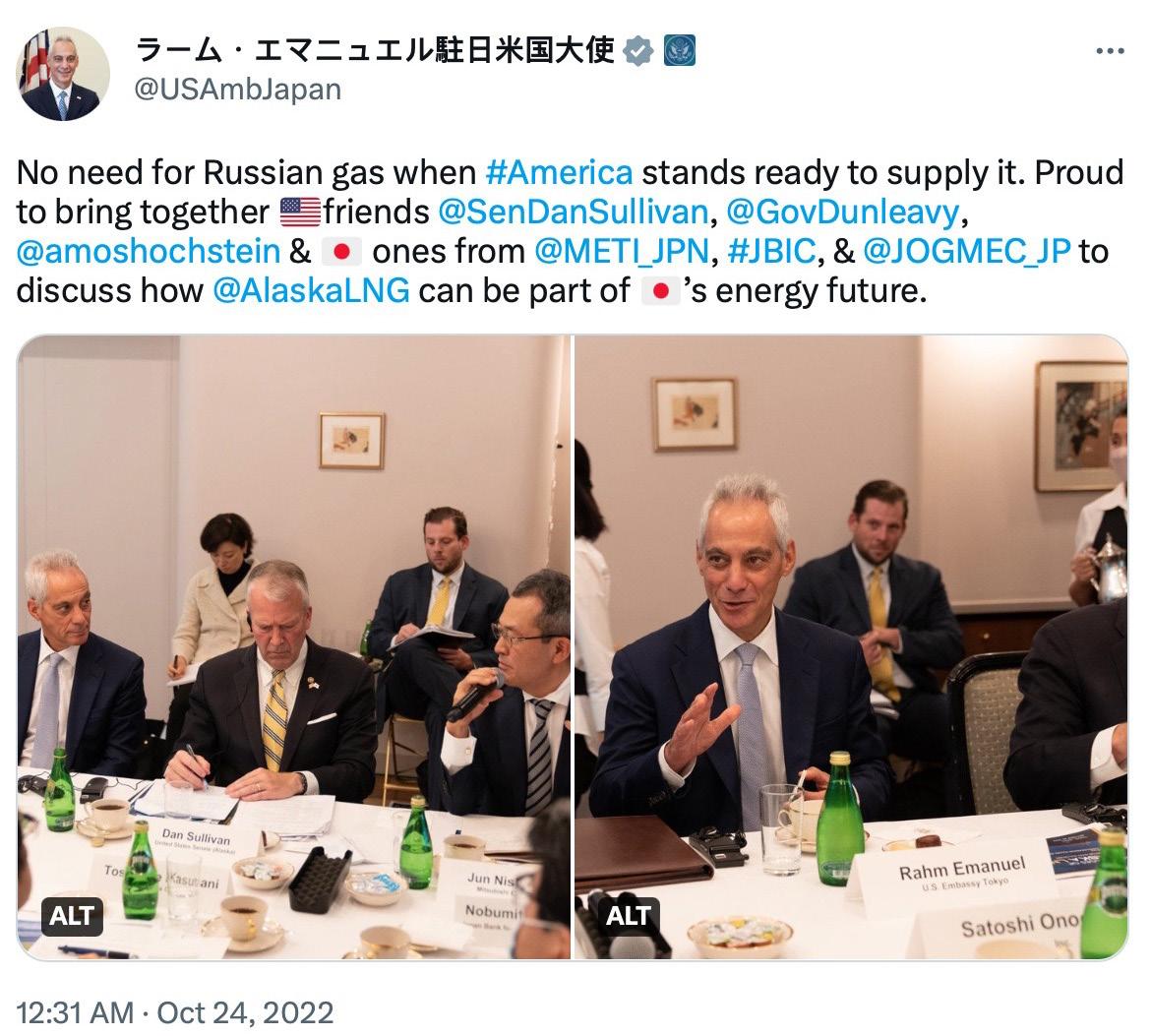
48 North America 2023
Figure 2. Alaska’s close proximity to Japan and other Asian markets gives Alaska LNG a major competitive advantage over more distant alternatives.
Figure 3. US Ambassador to Japan, Rahm Emanuel, convened a project summit in Tokyo for Alaska LNG to bring industry and policy stakeholders together to advance Alaska LNG.
value to international policy makers and energy industry officials. Last autumn, the U.S. Department of State convened a unique ‘Alaska LNG Summit’ in Tokyo, bringing together top Japanese government and LNG executives to advance formation of the partnerships required to develop Alaska LNG.
Summit leaders included U.S. Department of State Senior Advisor for Energy Security, Amos Hochstein, who The Washington Post reports is dubbed President Biden’s “energy whisperer” 3 and “has played a key role in advising Biden on international energy policy” during Biden’s time as both President and Vice President.
Other US participants included U.S. Department of State Assistant Secretary for Energy Resources, Geoffrey Pyatt, and US Ambassador to Japan, Rahm Emanuel. Following the summit, Ambassador Emanuel tweeted, “No need for Russian gas when America stands ready to supply it… Alaska LNG can be part of Japan’s energy future.”4
In a subsequent column in The Wall Street Journal, Emanuel elaborated: “Last year, Russia supplied about 9% of Japan’s LNG. Australia supplied the most, over 36%. The US already supplies Japan with 10% of its LNG, and we are ready to do more. Planned expansions in states such as Alaska could, based on private-sector studies, supply Japan’s current and future demand at a reasonable cost with much lower methane emissions than alternative LNG. Alaska LNG can travel to Japan in six days without any strategic chokepoints and can make Japan the energy export hub for the Indo-Pacific to reduce its coal dependency.” 5
Other important summit participants included US Senator, Dan Sullivan (Alaska), Alaska Governor, Mike Dunlevy, and AGDC’s Richards. Japanese energy industry attendees included senior representatives from INPEX, Mitsubishi Corporation, Tokyo Gas, and JERA.
Meeting Asia’s energy needs today and tomorrow
The consensus among energy forecasters is that global LNG demand will continue to grow for decades. But according to Richards, US and Asian energy leaders see Alaska LNG’s potential even beyond clean-burning natural gas.
Asian nations including Japan, Korea, and Vietnam have set aggressive emissions reduction targets, and the strategies of these nations incorporate low to no-emissions hydrogen and ammonia in their energy mix. Alaska has an enviously complete checklist of the items needed for launching commercial scale hydrogen and ammonia production derived from natural gas.
Hydrogen in the form of conventional liquid ammonia emits no carbon dioxide when used to produce energy, and ammonia is easier to store and transport than hydrogen gas. By unlocking the estimated 200 trillion ft 3 of natural gas on Alaska’s North Slope, North America’s largest untapped natural gas basin, Alaska LNG will drive hydrogen and ammonia production, as well as LNG.
The benefits of producing low-carbon hydrogen from natural gas are realised when the carbon released during hydrogen production is captured and safely stored in underground geologic formations. Alaska’s Cook Inlet, immediately adjacent to the planned Alaska LNG terminal
in Nikiski, Alaska, has an estimated 50 gt of carbon sequestration capacity, the best carbon sequestration potential on the US West Coast, according to geologists. Put another way, 50 gt equates to about five decades of emissions from the entire nation of Japan.
Alaska is also home to well-established energy infrastructure, including an existing ammonia plant located next to the planned Alaska LNG project LNG facility. This plant was idled due to declining Cook Inlet natural gas production, and natural gas via Alaska LNG enables it to resume operations.
Other Alaska assets include a well-trained energy workforce, widely respected permitting rigor, and stringent environmental, health, and safety standards, giving Alaska a well-earned reputation as a source for responsibly produced energy. And as the AGDC assembles the development team with the right qualifications and capitalisation to build and operate Alaska LNG, the stars are aligned for this project.
References
1. ‘ALASKA LNG PROJECT: Final Supplemental Environmental Impact Statement’, U.S Deparmennt of Energy, Vol. 2, (January 2023), www.energy.gov/sites/default/files/2023-01/ final-seis-0512-s1-alaska-lng-volume-2-2023-01.pdf
2. ‘Alaska LNG Competitiveness Analysis: Final Report’, Wood Mackenzie, (21 January 2023), https://agdc.us/wp-content/uploads/2022/01/WM_AlaskaLNG-Competitiveness-Analysis_FINAL_20JAN2022.pdf
3. JOSELOW, M., ‘Biden’s ‘energy whisperer’ balances climate agenda, rising gas prices’, The Washington Post, (19 June 2022), www.washingtonpost.com/climate-environment/2022/06/17/ amos-hochstein-biden-energy-gas/
4. Tweet published by Rahm Emanuel on 24 October 2022, https://twitter.com/USAmbJapan/ status/1584402209940602880
5. EMANUEL, R., ‘How Japan Can Avoid Europe’s Energy Mistakes’, Wall Street Journal, (4 December 2022), www.wsj.com/articles/japan-can-move-quickly-to-avoid-anenergy-crisis-europe-russia-nuclear-wind-solar-batteriesalaska-lng-11670169782
Alaska LNG consists of three principal infrastructure components
Arctic carbon capture (ACC) plant
Located in the Prudhoe Bay section of Alaska’s North Slope, the plant removes carbon dioxide and hydrogen sulfide before natural gas enters the Alaska LNG pipeline.
Natural gas pipeline
An 807-mile 42 in. dia. pipeline connecting the ACC plant to the LNG facility capable of moving 3.7 billion ft3/d of natural gas. The pipeline includes multiple offtake points to provide natural gas for in-state residential, commercial, and industrial needs.
Alaska LNG facility
Located at tidewater in Nikiski, Alaska, the 20 million tpy LNG facility features three liquefaction trains, two loading berths, two 240 000 m3 LNG tanks, and a jetty.
North America 2023 49
Christine Kennedy, President, Woodfibre LNG, Canada, provides insight into the history of the Woodfibre LNG project, and how the company is working to produce the lowest-emission LNG in the world.

50
Figure 1. Woodfibre LNG site.
Woodfibre LNG is a privately-held Canadian company that is constructing an LNG export facility about 7 km southwest of Squamish, British Columbia, Canada. The Woodfibre LNG Project is unique – for a few reasons.
The project’s history
Since 1912, Swiyát (the site’s traditional Squamish Nation name) has provided industrial opportunities for generations of local families in the community – Woodfibre LNG is keeping up this tradition. For over 100 years, the site (only accessible by boat), was home to one of British Columbia’s oldest pulp mills. In 2015, the company took ownership of the industrially-zoned site and began planning for the 2.1 million tpy LNG export facility. The site is already equipped with an existing natural gas pipeline, an existing electrical transmission line, and a deepwater port. Access to existing hydroelectricity on site will allow the project to reduce emissions by over 80%, and produce the lowest-emission LNG in the world.1 Powering the facility by renewable hydroelectricity from BC Hydro will result in 14 times fewer stationary combustion emissions than the liquefaction of a conventional LNG facility powered by natural gas.

Honouring tradition
The Woodfibre LNG Project has its regulatory approvals from the federal and provincial governments and is the first industrial project in Canada to recognise a non-Treaty Indigenous government, Sḵwxwú7mesh Úxwumixw (Squamish Nation), as a full project regulator. This is important because the project is situated within the traditional territories of the Squamish Nation. The Squamish Nation conducted an independent environmental assessment of the project and, in 2015, granted Woodfibre LNG an environmental certificate, which is the first legally binding, Indigenous-led approval of a project in Canada. The project, which holds a 40-year export licence, is subject to 25 unique Squamish Nation environmental assessment conditions that must be met throughout the life of the project. These will be monitored in collaboration with Squamish Nation. Woodfibre LNG recognises the importance of local and Indigenous economic participation in the project and works with project partners to maximise employment, training, contracting, and other business opportunities for local and Indigenous people.
Design changes
As a result of consultation with the Squamish Nation, Woodfibre LNG made important design changes to the project. Examples include:
� Changing the location of the facility from floating to on-land in response to concerns regarding potential impact on the marine environment.
� Changing the cooling technology for the facility from seawater to more environmentally-friendly air cooling, which also has emission reduction benefits.
Another early, fundamental design decision made in response to Squamish Nation concerns over potential air quality impacts was to power the facility with electricity from BC Hydro instead of natural gas. Woodfibre LNG is one of the first LNG facilities in Canada to commit to being powered by electric drive compressors using renewable hydroelectricity.
Prioritising emissions
Woodfibre LNG has prioritised emissions avoidance and reduction opportunities from the outset. Maintaining respectful and meaningful partnerships with local Indigenous groups underpins the project’s approach to developing its net zero roadmap and to building and running the project in a way that contributes to a resilient community in Squamish and a net zero future for Canada, and the world. In March 2023, Woodfibre LNG announced its Roadmap to Net Zero, making the export facility the first in the world to achieve net zero emissions, 23 years ahead of government regulation. The roadmap includes commitments to be net zero both through the construction stage of the project and during operations. The project’s net zero roadmap follows the British Columbia government’s announcement of a new Energy Action Framework, requiring proposed LNG facilities currently in or entering the environmental assessment process to develop and submit a credible plan to be net zero by 2030.
Woodfibre LNG was already designed to be the lowest carbon intensive LNG export facility in the world, with an annual emissions profile of 83,374 t of carbon dioxide equivalent (CO2-e)/y, and a carbon intensity of 0.04 (t of CO2-e/t of LNG), well below the Provincial benchmark of 0.16.
As part of its net zero roadmap, Woodfibre LNG will also offset emissions during the construction phase of the project. Woodfibre LNG’s robust strategy has been independently validated by a Canadian climate engineering firm, Brightspot Climate Inc., and is consistent with Canada’s Methane Strategy and draft guidance for best-in-class greenhouse gas emissions performance by oil and gas projects.
The facility will use hydroelectricity to power the main liquefaction process, including technology to enable compressors to restart without flaring, cameras, and leak detection and repair surveys to detect and remedy fugitive leaks. When considering emissions, Woodfibre LNG recognises the importance of the full lifecycle of emissions.
The natural gas fuelling the project
Responsibly-produced natural gas is a necessary part of making a successful global transition from heavy-emitting fuels to renewables. By harnessing the low-carbon gas resources of British Columbia’s Montney region to replace coal-fired energy sources in Asia through signed offtake agreements with BP, Woodfibre LNG will reduce global emissions by 3.5 million t CO2-e/y, equivalent to removing 5% of British Columbia’s annual emissions from the atmosphere every year.
The natural gas required by the project will come from Woodfibre LNG’s upstream affiliate company, Pacific Canbriam Energy, in Northeastern, British Columbia. Pacific Canbriam Energy will deliver feed gas via an existing pipeline that will be extended (gas from the region is transported to the Vancouver area by Enbridge’s T-South pipeline) to the Woodfibre LNG facility from its reserves in the Montney Altares and Kobes Montney regions. In 2021, Pacific Canbriam Energy became the second gas producer in North America to achieve EO100TM Standard certification for the production of Certified Responsibly Sourced Gas (C-RSG). This distinguished certification confirms Pacific Canbriam’s leadership in the use of innovative and transparent practices and processes to produce some of the world’s most sustainable and responsible natural gas. Both Woodfibre LNG and Pacific Canbriam Energy are located in British Columbia, which attests to both companies’ adherence to
51
some of the world’s most stringent environmental regulations and policies to ensure sustainable and responsible production of both natural gas and LNG.
Transforming the site
Woodfibre LNG is an industrial transformation project that is helping to improve the environmental condition of a historic pulp mill site that operated for over 100 years.
The project has been conducting remediation work since 2018, which has included the removal of approximately 4000 creosote piles, hundreds of old tyres, and tonnes of rebar and concrete. To date, Woodfibre LNG has invested over CAN$12 million in site cleanup. Remediation work has created local employment opportunities with contracts awarded to seven British Columbia-based companies. Site preparation activities are currently underway to prepare for the start of construction in September 2023. This includes more concrete recycling, demolition of old buildings, landfill capping, green zone activities, soil remediation, shoreline rehabilitation (including continued creosote pile removal), and habitat offsetting.
Woodfibre LNG continues to take progressive steps towards being prepared for climate change and natural disasters as outlined in its net zero roadmap.1 This includes developing management plans for fire abatement, wildfire threats, floods and debris flows, sea-level rise, coastal hazards, and undertaking baseline studies on hydrological and meteorological elements.
In 2021, Woodfibre LNG signed an EPFC contract with McDermott International. The EPFC contract was followed by a Notice to Proceed (NTP) in 2022 that signalled an important step in advancing detailed engineering and construction
scheduling work. Enbridge took a 30% non-operating stake in the Woodfibre LNG Project in 2022.
It is estimated that up to 800 people will work on the Woodfibre LNG site at peak construction. McDermott will manage onshore construction, leveraging regional-based contractors and commitments included in Woodfibre LNG’s Impact Benefit Agreements with the Squamish Nation. The EPFC contract commits McDermott to Woodfibre LNG’s hiring priority for qualified Squamish Nation members and local workers first, followed by British Columbians and then other Canadians. The joint priority is to create a safe, inclusive, and respectful workplace that brings benefits to the project’s Indigenous partners and local community.
Looking to the future
Within the next four years, the Woodfibre LNG Project will start production, and will be the lowest-emission LNG facility in the world. 2 The facility will create 100 new operations jobs which will remain for the lifetime of the project, maintaining the legacy of this unique site in British Columbia that has been rich with industry for decades and with Indigenous history for millennia.
The world needs Canadian LNG. Woodfibre LNG is demonstrating that it is possible to produce certified responsibly sourced, low emission energy in a way that aligns with environmental goals and indigenous reconciliation priorities.
References
1. ‘Woodfibre LNG’s Roadmap to Net Zero’, Woodfibre LNG, https://woodfibrelng.ca/about-woodfibre/sustainability/ emissions-reduction/
2. 0.04 t of CO2-e/t of LNG produced – typical LNG projects (such as in the US) can be as high as 0.26. Source: https://woodfibrelng.ca/emissions
Advertiser Page Analytical Solutions and Products B.V. 04 Bechtel 15 Chart Industries OFC, 21 Chevron OBC Damen 19 Hydrocarbon Engineering 46 Johns Manville 11 LNG Industry 37 Advertiser Page Mokveld 09 OPW Clean Energy Solutions 33 PETRONAS IFC, 01 Quietflex Manufacturing 25 Stirling Cryogenics IBC VEGA 02 World Pipelines 45 ADINDEX www.lngindustry.com LNG Industry is audited by the Audit Bureau of Circulations (ABC). An audit certificate is available on request from our sales department.
MICRO SCALE
MICRO SCALE
• Plug and play modular design
• Plug and play modular design

• Turn-key projects
• Turn-key projects
• More than 65 years experience
• More than 65 years experience
• Power consumption as low as 0.62 kWh/kg LNG produced
• Power consumption as low as 0.62 kWh/kg LNG produced

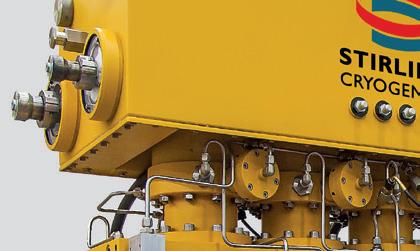
• Easy scalable for future growth
• Easy scalable for future growth
• Stirling Cryogenics is involved in 15 commercial bio-LNG projects spread out over the whole of Europe
• Stirling Cryogenics is involved in 15 commercial bio-LNG projects spread out over the whole of Europe
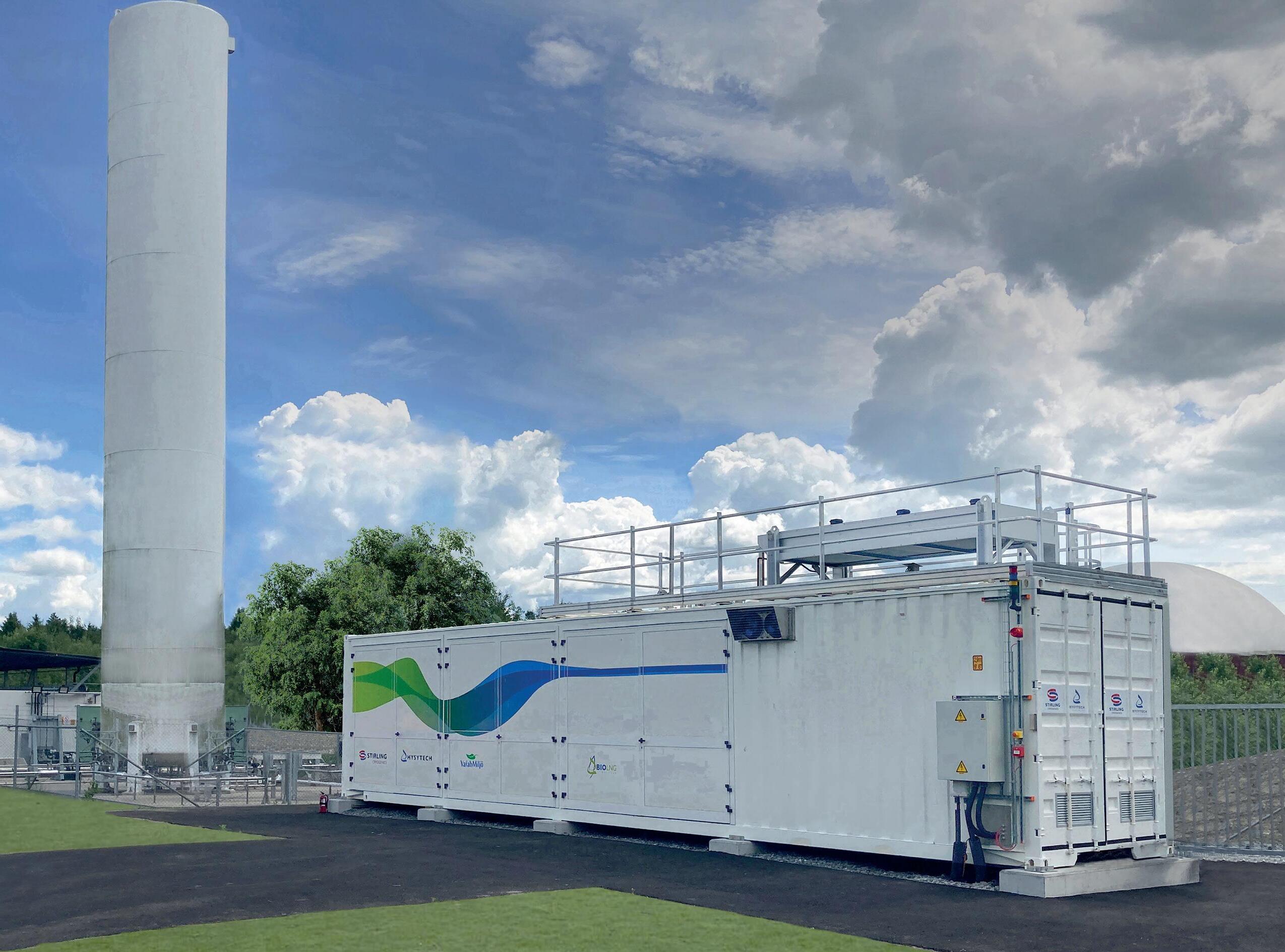
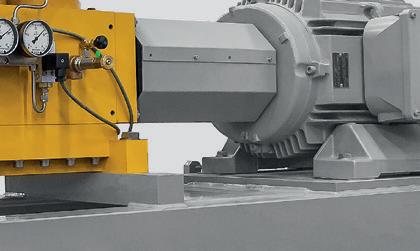

Stirling Cryogenics
Stirling Cryogenics
+31 40 26 77 300
+31 40 26 77 300

info@stirlingcryogenics.eu
info@stirlingcryogenics.eu
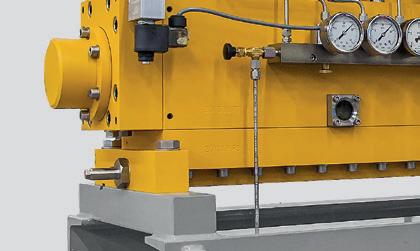


www.stirlingcryogenics.eu
www.stirlingcryogenics.eu
In cooperation with:
In cooperation with:
MEET US AT BOOTH NO. 1304






















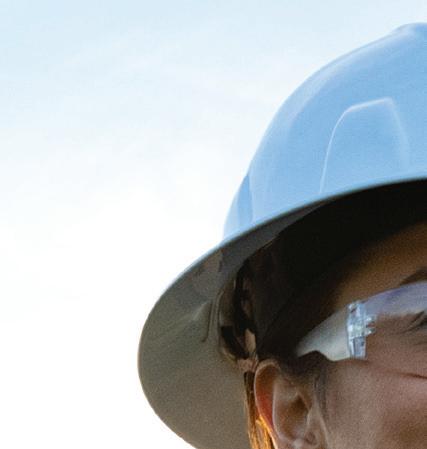
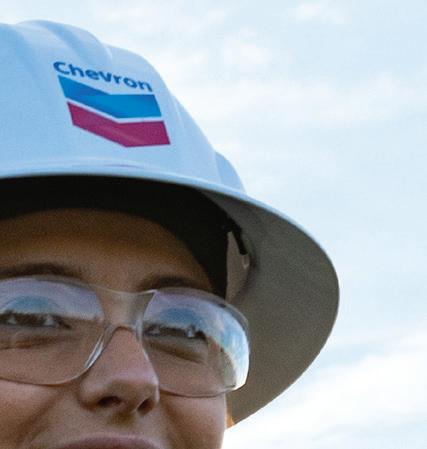


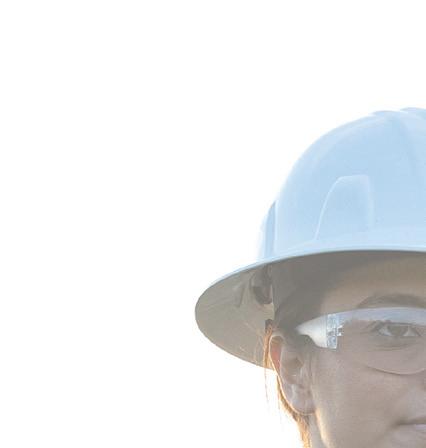
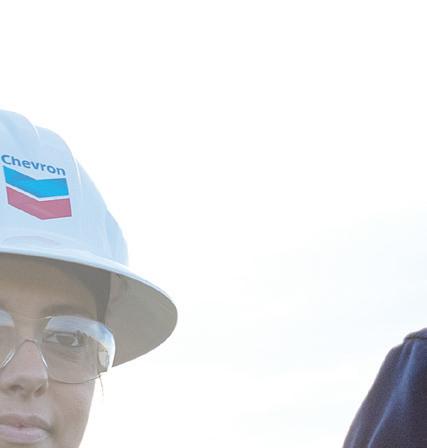



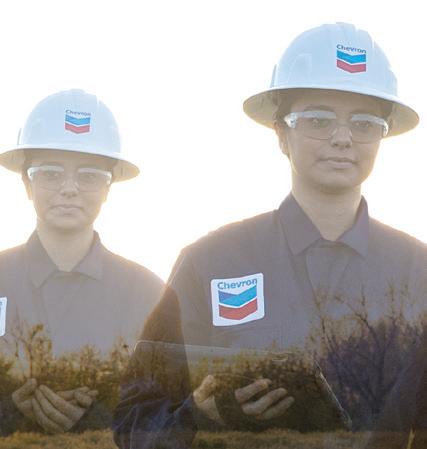


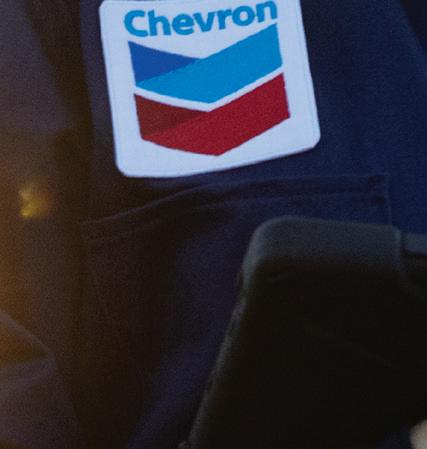



























 JESSICA CASEY DEPUTY EDITOR
JESSICA CASEY DEPUTY EDITOR














































































































































































